#then I multiplied it ×4 because that how many sections I plan to have and you guys...
Explore tagged Tumblr posts
Text
7,876... idk what to say. I wrote and wrote until the creativity voice went quiet for the day. Let's hope I'm this productive tomorrow!
#writing#smut#coriolanus snow smut#tbosas movie#the ballad of songbirds and snakes#coriolanus snow#coriolanus snow x reader#tbosas#you know what I realized?#i whipped put my calculator and did a little hypothetical equation for myself#i put what if for every section of this fic I wanna writing#I wrote 7000 words#then I multiplied it ×4 because that how many sections I plan to have and you guys...#2800 WORDS! that like a fairly small novella but a novella#notheless#I'm-#I'm trying I'm hope I get this done and if I don't I forget about the other parts and just release what already have written#but that's a last result for me because i really want it to be formatted as one thing#also how are we feeling about slightly dom!reader?#because that's the vibes the reader gives off to me in this one#don't blame me blame my imagination that came up with her#anyways slay lol#but honestly this is probably the most driven I've felt to finish something in months#but I don't want to jinx myself#knock on wood#coffee (my silly little (rabbit) caramel frappe I make at home) is helping me get through#i hopped on caffeine and the ideas start spewing out on me sometimes or I just get tachycardia#winning
14 notes
·
View notes
Text
Springtime Beneath the Heavens - The Coming of Dreams, Encircling Fate 10

(Location: Café COCHI)
(Some days even later. The week after the “ES Idol Directory” goes on sale.)
Eichi: Everyone. Thank you again for lending your help. Thanks to you, we were able to make a wonderful directory.
Rei: Getting praise from Tenshouin-kun is weirdly creepy(1). Leave the flattery at that.
Eichi: It’s not flattery. The gravure(2) on the front is received well by the world.
I almost couldn’t believe it’s the same people who ran around a mountain to look for the white snake. Fufu���
Tetora: The talk interview article is really good too. It seems fun, and even then, there seems to be stuff I can relate to. I read it all in one go.
Every single photo really was perfect! I got a new goal: one day, I want to be an idol who could be displayed on the cover of the directory too!
Eichi: What splendid enthusiasm. I’m surprised it resonated with you as well, Nagumo-kun.
Just as the name suggests, this “ES Idol Directory” is jam-packed with the latest information of ES Idols.
That aspect might not feel that fresh to us active idols.
However, to new idols, or to little ones aiming to become idols, it might be a single volume packed with dreams and hopes.
What you’ve said in the talk interviews—— I’m sure there are little ones who admire those experiences and words and embrace them, using them to prop them up for the future.
Fufu. I feel like Sena-kun would say that “It’s annoying when my rivals multiply”.
Izumi: You, aren’t you looking down on me? I’m not going to be flustered over something like that.
No matter how many stardust multiply, in the end, they’re still stardust. But it’s going to be different if they could emit true brilliance.
Still, I have the self confidence that I will be able to keep my composure and be ready for it, because I plan to have the strength to back it up.
Hokuto: I couldn’t believe this is coming from someone who declared that his hobby is “Teasing juniors”.
Izumi: Your information’s old, you know? …….See, look at this.

Hokuto: …… Your hobbies are “Health management, cycling”?
Izumi: Each agency did a profile renewal due to the production of the “ES Idol Directory” didn’t they? That’s when it was erased.
Hokuto: I see. But the past that you did tease juniors itself couldn’t be erased.
Izumi: Shut up. What about you?
Hokuto: You mean about my hobbies? They’re “Movie appreciation, Crossword puzzles”.
Appearing on Fist of Idol; Togenkyo was the impetus for me to watch movies more frequently, so I added “Movie appreciation”.
Rei: Oh. You’re matching with me.
Hokuto: Did we clash? …… I kind of feel bad because it feels like our info(3) clashed. Can we change it even if it’s late?
Eichi: It’s impossible. How could we reprint just for your sake?
If you change the information registered in your agency, it would look like the directory has a misprint. Accept it graciously.
Don’t worry about it. Compared to the amount of people who put in ‘Reading’ as their hobby, not many people are clashing with you.
Rei: Don’t say any more than that, Tenshouin-kun. You’re going to hurt me, who wrote down both ‘Reading and ‘Movie appreciation’ as my hobbies.
Eichi: But you’re not that sensitive♪ Look at our Wataru’s(4) hobby section and cheer up.
Nagisa: …… Wataru-kun has a variety of hobbies. It’s wonderful.
Tetora: It feels like he wrote as much as he could think of with how much he wrote~
......Eh? It feels like Ran-senpai’s specialty is different from before.
U~myu. I don’t remember what it is specifically. But if I remember correctly, it feels like it wasn’t acting……?
Nagisa: ……. Mm. I previously wrote “Can do anything”. To give off a sense of omnipotence.
...... But I changed it, because there are a lot of things I don’t know.
...... All things considered, you did well to notice, didn’t you?
Tetora: Because it had a strong impact on me. So much so that even when I couldn’t remember the details, I just slightly remember it.

Nagisa: ……. Oh yeah. I have souvenirs for Tetora-kun and everyone else.
Tetora: Souvenirs? …… Ah, from the Mystery Researchers!
Nagisa: …… Mm. Kanata-kun said the kids from Ryuseitai have been to Okinawa, so I thought a normal souvenir would be no good.
...... I made Shisa(5) statues with everyone’s faces on them.
Eichi: Shisa statues with our faces on them.
Rei: Kukuku. I did gently suggest a different souvenir, you know? But he said that “Something unique is better”, so I couldn’t suggest too strongly.
Eichi: Is that so? Since it’s you, you could have thought it was funny and didn’t stop him.
Tetora: …… Oh. The Shisa is from the neck downwards, but the face itself is me.
Izumi: Mm, it looks like a exact copy so it’s scary. Did you not think to like, deform(6) it a little?
Nagisa: ……. No. Because I paid attention on them being true to life.
...... Shisa also hold meaning as a ward against evil, you see. It seems that it protects the house where it displayed on the roof at.
....... I’d like everyone to display it in your rooms.
Hokuto: What about your sacred site visits? Did you feel something?
Rei: Geez. Young people nowadays always want quick results. Change won’t call on you that easily.
Nagisa: …… At the beginning, it was the white snake dream. When searching for it in the courtyard, Tetora-kun and Sakuma-kun joined me, and it led towards a new job…….
....... Unexpectedly, we ended up going to Okinawa. Thinking back about it, it feels like everything was connected.
...... Being able to experience new things is thanks to good fortune. I want to believe that something will happen again.
...... I will work as hard as I can so I don’t fail to notice that ‘something’.
...... So that I don’t embarrass myself as an idol displayed on the cover of the directory.
TL NOTES
むす痒い (musu kayui): feeling the creepy crawlies, or simply itchy.
グラビア (gravure): Gravure or photogravure is simply an ink printing method. Photos printed by photogravure had the reputation of being good quality. However, in a more recent context (in Japan), this refers to fanservice-y glamour photos of idols.
ネタ(Neta) : in this context, printed material or information. This word could also mean ‘joke’ or ‘trick’, as used in the Perplex story.
うちの渉 (uchi no Wataru): Wataru belonging to (group/me). Feel free to read this as ‘my Wataru’ if that’s more your style.
シーサー (Shisa): Okinawan guardian dogs.
Deform: Chibify.
Previous | Directory
#ensemble stars#enstars#enstars translation#nagisa ran#rei sakuma#izumi sena#hokuto hidaka#tetora nagumo#era: !! year 2#type: scout
0 notes
Text
The Relief of Letting Go
Today's inspiration comes from:
A Faith That Will Not Fail
by Michele Cushatt
"If you love anything at all in this world more than God, you will crush that object under the weight of your expectations, and it will eventually break your heart." ~ Timothy Keller, prayer
"'For as long as I can remember, I dreamed of being a mother. I pictured a house full of children, family holidays filled with laughter and traditions, photo albums filled with school pictures, family vacations, and momentous events. This desire influenced where I chose to attend college and how I built a career. I didn’t want anything to get in the way of my dreams of family. Which is in large part why finding out I had cancer while I still had young children at home wrecked me. I looked at my children and couldn’t bear the thought of missing out on their lives.
What pained me the most, though, was the very real possibility that I could die, and then someone else would take my place as my children’s mother. I didn’t want anyone else to play wife to my husband or mom to my children. That was my job. And the fact that I might not be around to fulfill it haunted me. As a result, I tried to hang on to them more tightly. Of course, the tighter you cling to people, the more they resent it. What felt like love to me felt like a stranglehold to them.
This is often the case with more than just people. Try to grasp love, and you’ll lose it. Reach for affirmation and attention, and they will remain elusive. Try to seek financial success, and you’ll miss out on it. Hold it all loosely, though, and you just might find what you were looking for.
In 1857, a twenty-year-old businessman surrendered to God. Although not rich by human standards, he had a solid head for business and desired success. But on his twentieth birthday, he came to a deep awareness of God’s reality and determined to surrender it all to Him, including his dreams of personal and financial success.
On that particular day, Thomas Maclellan penned a prayer releasing his dreams and plans to the will of Christ. This radical relinquishment is difficult to do at any stage in life, even for those who have followed Jesus for decades. But it’s hard to imagine a twenty-year-old aspiring businessman releasing his future and pending success so fully into the hands of his God. And yet this is what Thomas Maclellan did.
“To Thy direction also, I resign myself and all that I have to be disposed of by Thee as Thou shalt see fit. To Thee I leave the management of all events and desire that Thou enable me to say, without reserve, not my will but Thine be done. Knowing that Thou govern all things wisely and will ever do that which is best for me.”1 This is only a small section of the covenant he penned. But it provides a glimpse of his relinquishment of those things he would, otherwise, be tempted to cling to.
Fast-forward more than a hundred and fifty years and Thomas’s covenantal prayer has multiplied into the Maclellan Foundation and more than $600 million in total donations. One man’s willingness to give himself to the will of God has now become generations of men, women, and dollars reinvested in the kingdom. All because one man was willing to let go.2
There’s a story told in the gospel books of Mark and Luke about a poor widow who came to the temple to give her offering (Mark 12:41– 44; Luke 21:1–4). Moments before, Jesus had issued a warning against the teachers of the law, blasting them for their displays of religiosity while “devour[ing] widows’ houses.” They aimed for fame, grasping for attention and recognition. But they failed to see those who needed them most of all.
This is the gift of letting go... of relinquishing all we have, even our lives, to a God who sees.
Against that backdrop, a widow entered the temple along with a crowd of worshipers with offerings. Many deposited huge sums, making quite a show with the sound of their gifts. But the widow offered a couple of coins, an amount so small that no one noticed. Her contribution couldn’t possibly make a difference. It was less than nothing.
Jesus noticed:
Truly I tell you, this poor widow has put more into the treasury than all the others. They all gave out of their wealth; but she, out of her poverty, put in everything — all she had to live on. — (Mark 12:43–44)
Whether your gift is money or ministry, it is possible to give large amounts without giving anything at all. And it is possible to give little and yet give everything. The widow did what so many others find difficult: she held nothing back. Proving that God Himself was indeed her truest treasure, she relinquished all of her earthly riches. And in the end, she left far richer than the rest.
This is the gift of letting go, of relinquishing all we have, even our lives, to a God who sees. Your sacrifice matters, no matter how big or small. Trust Him with it and watch as your faith grows in the giving.
Five-Minute Faith Builder
I have been crucified with Christ and I no longer live, but Christ lives in me. The life I now live in the body, I live by faith in the Son of God, who loved me and gave himself for me. — Galatians 2:20
Much like the widow with her two coins, Thomas Maclellan relinquished his life to his God in a prayer on his twentieth birthday.
“Consecrate all that I am and all that I have, the faculties of my mind, the members of my body, my worldly possessions, my time, and my influence over others, all to be used entirely for Thy glory and resolutely employed in obedience to Thy commands as long as Thou continuest me in life.”3
Read this section of his prayer one more time, and highlight any words or phrases that are meaningful to you. Then find a quiet place, absent of distraction, and pray Thomas’s prayer aloud, releasing your life into the hands of the God who loves you more than all others.
To Him who is able to keep you from stumbling and to present you before His glorious presence without fault and with great joy. — Jude 24"'
“Our Covenant,” Maclellan.net, https://maclellan.net/our-covenant. “Our History,” Maclellan.net, https://maclellan.net/our-history. Thomas Maclellan, “A Wholehearted Covenant,” Renovaré, https://renovare.org/articles/a-wholehearted-covenant. Excerpted with permission from A Faith That Will Not Fail by Michele Cushatt, copyright Michele Cushatt.
0 notes
Text
The Full Metal Alchemist Live Action Movie Part 8: Watch This Episode Covered in Butts be the Only One Not Flagged by Tumblr
Gonna be risky business and not only upload all of these caps the way I screenshot them--which has just SO MANY poorly CGI’d butts but also gonna do it on the Tumblr Drafts folder, which I have been assured works now.
I’m so worried about so many things, but considering all the fears I have about like...everything else in the world right now...I guess I’ll take a risk on tumblr.
Edit: I cannot believe that I had 8ish episodes of Kaiba’s tall dueling tower get flagged but not this movie. I just....wow I cannot.
So anyway, last we left off, General Hakuro stepped in and was like “Hi guys, you like my wily plans that no one in their right mind would have ever guessed???”
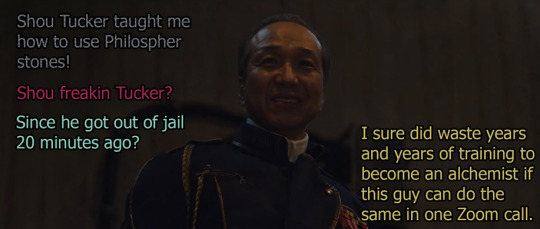
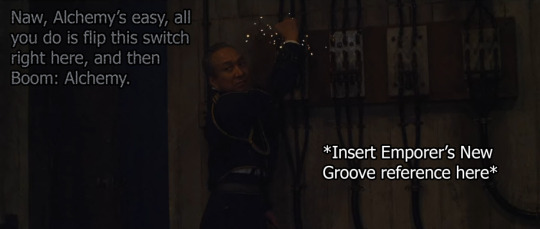
Yo remember this part of the anime? Where the bodies drop from the ceiling and it’s a hunk out of the final arc--it’s here. In this movie. This movie that can’t possibly afford to do that. Lets get some CGI animated bodies in here ASAP.
(see some texture regrets under the cut)
It’s like a Monet, as the Mean Girls say, because far away and shrinked to 500 pixels this looks kinda neat. They sort of look more like those slime ball that grow in the back of your throat rather than human bodies, but they still look pretty gross hanging up there.

But then.....we zoom in. Remember again that this was full screen on my computer, and at one point was on a freakin movie screen. This level of 3d...was on a movie theater screen.
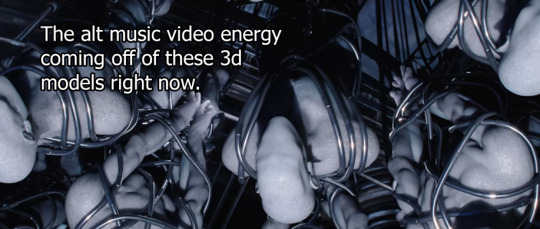
The mind boggles. The mind boggles!
Like as you know, I am an artist, and I’ve dabbled in...basically everything in my pursuit to make a dollar...and I have taken about 2 years of classes in 3D art with Maya and all those. I’m not thaaat great at it--I’m much more an illustrator/painter--but I feel like I have that reference point. Can I just say--the model is...fine...you can do a lot with layers of bump maps so you don’t need a truly detailed model (not like they did that, because they didn’t do that, but I can figure that maybe they had an intention to do that and forgot?)
But, there’s no connection of the wires to bodies. They just kinda float? The bodies are also all the same shiny-ness? To the point that it looks like a copy paste? (I don’t think it is, the wires are slightly different on a few of them) There’s just not much in the way of a texture map or a bump map. It just...there’s also something missing from the skin.
Skin is actually kind of rough to render, so when I did it back in the day, I followed like a checklist to make sure I had all the layers and steps to make someone look...clammy. Some things are kinda translucent, they reflect light a different way...especially white skin like this wouldn’t be just...white like putty. Dunno if you ever saw a white person, but we got so many veins...there was so much potential to make something really gross and fleshy.
Instead we got silly putty. It’s fine. I’m fine.
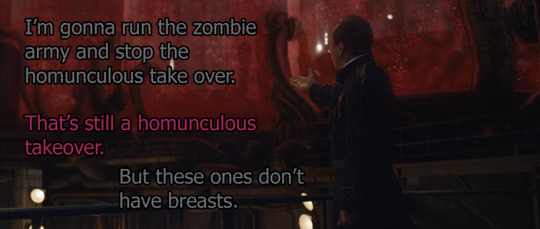
So General Hakuro decides to just...kill everyone right now.
This makes no sense to me.
That means that the whole thing of Lust killing Hughes was completely unrelated to General Hakuro. All Hakuro needed was Shou Tucker, who has been in prison for...I assume months since Ed shipped him off. And Shou was only released today? Just now? Just now when Hughes was shot?
So this all just happened at the same time by accident?
I mean the General sent us to the wrong lab initially, so he didn’t actually want us to be here, and now that we are here, he’s going to set off an entire army as a reaction to three people walking in and going “oops”?
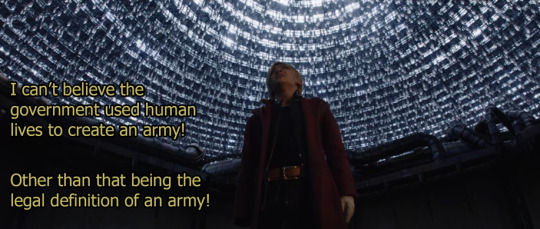
So, lets get a look at our army.

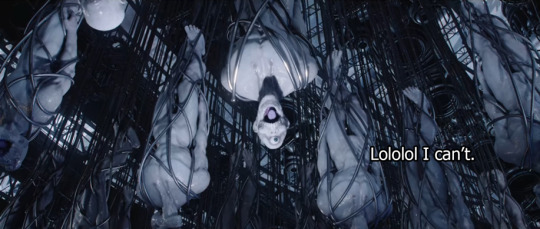
Oh it was so disappointing, this reveal. Not just the eyeball that has a bounce light coming from below the top lip there (how did that even happen???) but also when it opened it’s mouth, it had a flat animation of skin breaking--it wasn’t actually rendered 3d skin, it was like a jpg wrapped around it or something (or at least that was the illusion I got. That is fine for a video game or a TV show, but this is a movie. This is shot so that it can be displayed in a size bigger than your own house.
What happened to the animation team on this one? Not saying I can do better, cuz no, I can’t, that 3d chapter in my life was a while back, but I’m just one guy. This was an entire animation studio and they just...didn’t render 3d face ripping (which is their entire job, to work in 3d) and then they kinda just turned on the stock physics dynamics and dropped em instead of animating them.

The way they fell was like fish from a bucket--the same amount of speed, too. they all ragdolled like a 3D shooter, their rigs just hanging on for dear life (and yes, you could see the deforming happen on the joints of these models.) I’m fine with having a computer program render something out with a physics engine...but there is a balance.
You do have to still go in there and finangle it back because...real life is hella stupid. Real physics? So stupid. It was hilarious how nonthreatening it was, too because they’re like...the size of shrimps in that zoom out image. The scale is just so wild!
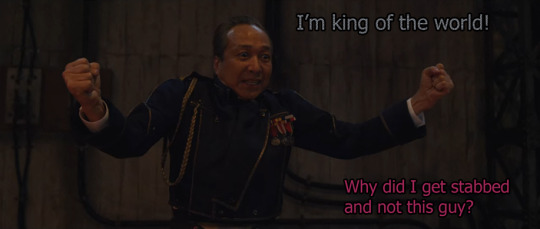

It was like one bored guy in a sound booth and they multiplied his voice three times. Golden. Absolutely golden.
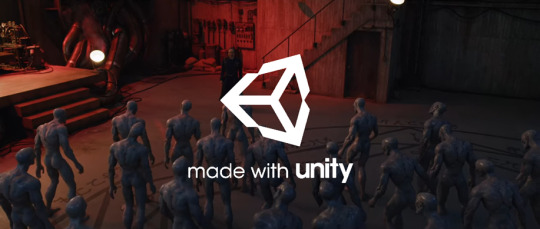
So these guys stride over, all of them with the same amount of speed (leading me to think it was probably a recorded walk cycle they all share with slight alterations between all of em) and they kinda just...pile on eachother in a weird way.
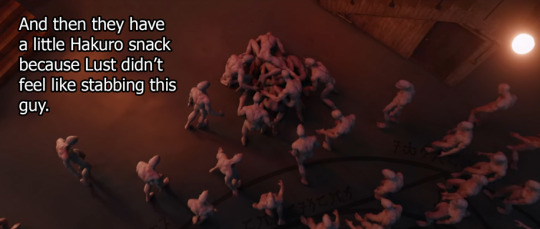
I will give them this: I was happy to see something that wasn’t physics or procedural. They mo-capped and animated that part for sure. It had the touch of an artist’s hand. It was also a very funny way for Hakuro to die because this guy was on screen for like 5 minutes, and maybe 7 minutes of this whole movie.
Youknow...I think it really says a lot about your nude 3d models if they’re not disturbingly human enough to trigger the tumblr filter, youknow?
Anyway, Envy looks on.
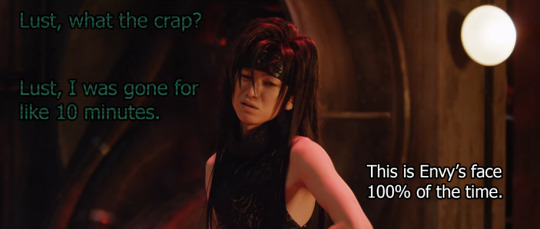
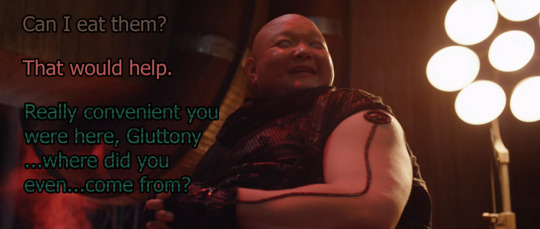
And then Gluttony saves the city.

Meanwhile, they decide to bust out the fire effects and Mustang becomes the most useful person in this entire movie. Like honestly this movie was poorly named, because it should have just been “Mustang saves the FullMetal Alchemist’s Entire Ass.”
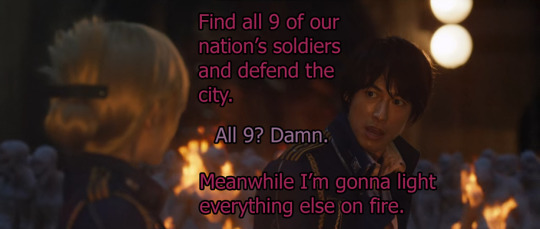
The next part seems like I forgot a cap, or maybe missed something. I swear to you, I did not.
First off, Al becomes fullmetal and makes this happen without an alchemy circle. The show doesn’t really care to talk about that though, it’s just a thing he can do now, and you’d only notice it if you were writing a Tumblr post about it.
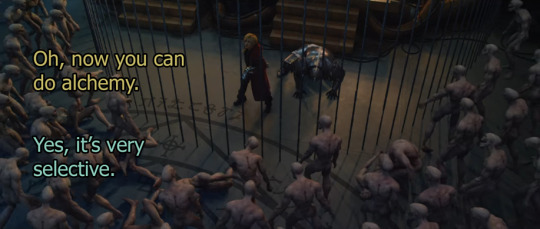
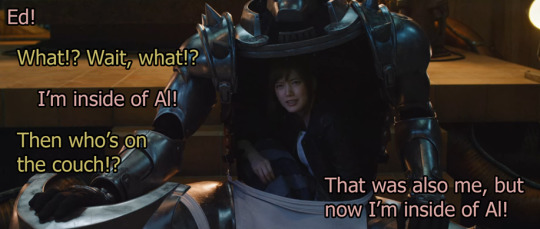
I swear to you, Winry is just inside of Al and there is no explanation.
There is no explanation for this.
She was on the couch...why is she not on the couch? What?
And then when you think they might have a moment, Ed’s like.
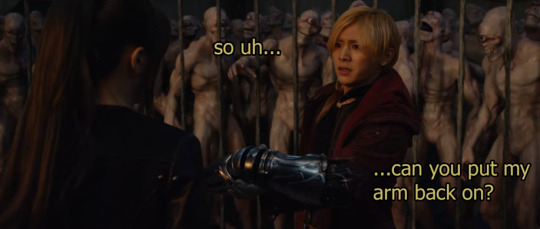
Damn.
For reals what the hell was that entire scene except for a way for Ed to get his arm stitched back on in like 2 minutes?
Outside, Envy and Lust are just strolling around the back-alley of this red brick building we have seen used for this entire movie.
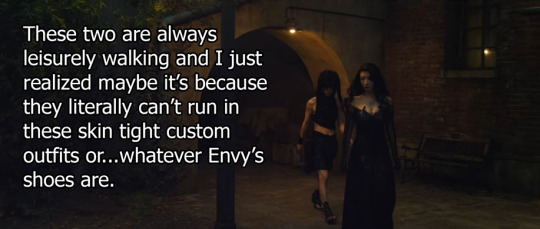
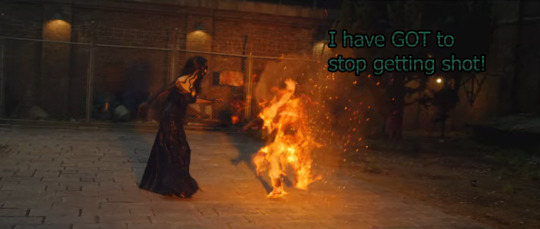
And like...it’s so funny to me because they weren’t trying to run or hide. It makes complete sense why they got shot. This is what happens when you just...walk away when the whole military guard wants to kill you.
Now lets go see how Hawkeye is faring.
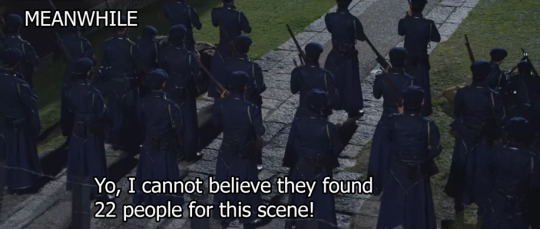
Luckily, all of the ambling bodies have decided to walk slowly through this one weird grass section between extremely long buildings.
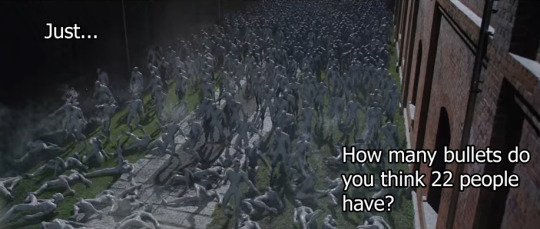
And Hawkeye tells everyone “You have to shoot their heads off” and I want you to look at that scene and tell me how many of those bodies still have heads.
Oh, all of them. Don’t worry about it.
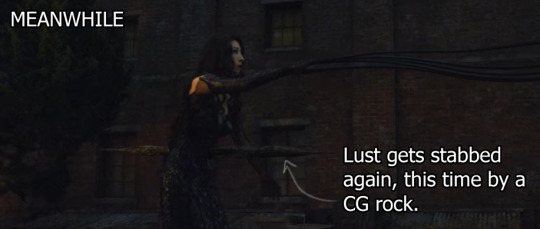
Kinda hard to see, but Ed shows up to give Mustang a hand, which was fully unnecessary but we’ll get to that in a bit.

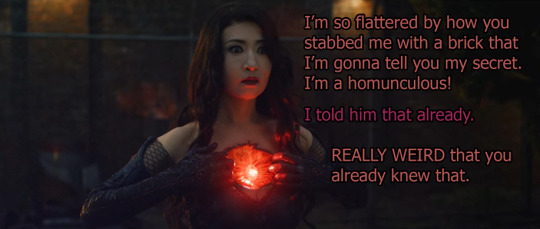

This movie is such a gem.
Ed goes big brain and realizes that Envy is still burned up, and thus is about to pass on.

And whatever, I’ll take it. It’s not like the movie has told us that they are made out of 1000000 lives, for all we know, in the movie universe, they really are only 4 lives. Like half a cat. Maybe Father only killed half a cat instead of an entire city.

Yugi Muto would be so freakin proud of Envy for how often this guy gets hit square in the chest with fire balls. It’s basically every scene where Envy and Mustang share screen time.
And don’t worry, I don’t think Envy died? But they sure made it look like he did, which I’m sure everyone everywhere was really happy to see, since Envy’s death was one of the climaxes of the whole series. Like people used to make these lists of “top 10 saddest anime deaths” and how many people had Envy on there? Like everyone? People freakin love Envy and they did him so much dirty in this movie.
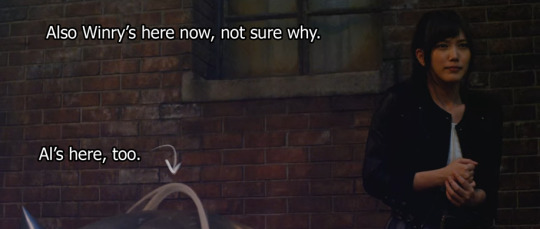
Again I have no explanation for Winry.
So Mustang is like, Ed, you make sure Winry doesn’t biff it in that corner, and I’ll do my actual job over here on this side. And yo, he did.


And so then that’s it, Lust is dead, and now we have a Sorcerer’s stone.
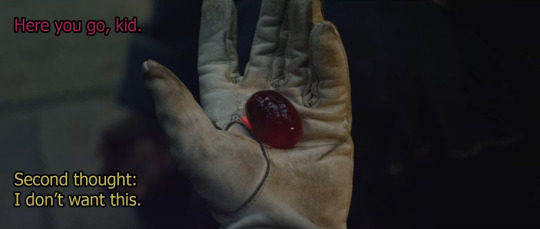
Man it looks delicious, right?
I’d eat the hell out of that.
Anyway, we only have one more update and we’re done with this movie!
I know!
I know! They only have 10-15 minutes to resolve pretty much everything, and that’s assuming that the credits don’t take up a heap of that. Hell, I might only have 3 caps next episode if that’s all credits. I honestly don’t remember.
Anyway, hope y’all take it easy this February, here is a link for people who just got here to read these FMA recaps in Chrono order.
https://steve0discusses.tumblr.com/tagged/fma/chrono
#FMA#Fullmetal Alchemist#Fullmetal Alchemist Movie#recap#photo recap#ed elric#colonel mustang#hawkeye#al elric#Winry Rockbell#so much fire#so much almost there CG
8 notes
·
View notes
Text
11/07/2020 DAB Transcript
Ezekiel 16:42-17:24, Hebrew 8:1-13, Psalms 106:13-31, Proverbs 27:7-9
Today is the 7th day of November welcome to the Daily Audio Bible I am Brian and I guess this…well…it’s the 7th day of November, so I guess it’s our first full week that we’re about to complete in this 11th month of the year. So, let's dive in. We’re reading from the Evangelical Heritage Version this week, which is today. Ezekiel chapter 16 verse 42 through 17 verse 24.
Prayer:
Father, we thank You for Your word, we thank You for this first week of this new month that we’re in as we continue our journey with You. And what a journey it has been. We began a journey thinking that we were going to go through the Bible and then we found each other, and we were going to the Bible in community. And then we…we learned things that You were speaking to us as a community and as individuals, only to find out You have been with us the whole time. You have been guiding and directing and protecting us the whole time. Even when we were Your enemies You still loved us. And, so, it's been a year of discovery and this year, this disruptive year has forced to us to reconsider the old ways, and to reconsider where we’re going. And we can consider all we want but what we deeply want to consider is where You’re going because that's where we want to go. That's where we want to be. We want to be a part of what You are doing. And we thank You for Your word because it leads us on that path, it teaches us, it makes us aware of Your presence in our lives. And, so, we continue to be aware. Come Holy Spirit, well up from within as we become aware that You are within us, leading and directing and guiding us. May we see it clearly. We ask this in the mighty name of Jesus. Amen.
Announcements:
dailyaudiobible.com is home base, it’s the website, indeed where you find out what's happening around here. So, stay connected.
And as we say often, the Community section is a place to go to get connected. It’s is where the Prayer Wall is and lives. You can also check out the Shop. The Daily Audio Bible Shop is full of resources that…yeah…they are made to accompany our journey here. So, check that out as well.
If you want to partner with the Daily Audio Bible, you can do that dailyaudiobible.com also. There is a link on the homepage. If you're using the Daily Audio Bible app you can press the Give button in the upper right-hand corner, or the mailing address is PO Box 1996 Spring Hill Tennessee 37174. And I thank you humbly and with all of the gratitude that I can use out of my vocabulary. Thank you for your partnership. We wouldn't be here if we weren't in this together. Thank you.
And, of course, as always, if you have a prayer request or encouragement, you can hit the Hotline button in the app, which is the little red button at the top, that looks remarkably or at least hopefully like a Hotline button. So, you can hit that no matter where you are the world, or you can dial 877-942-4253.
And that's it for today. I’m Brian I love you and I'll be waiting for you here tomorrow.
Community Prayer and Praise:
Hey DAB it’s __ J calling from Cleveland Ohio just saying hello to everybody wishing everybody well today. I know it’s been so many things going on. __ I’m praying for you all. It’s been a minute since I’ve called in. Been a heavy, heavy year. I shared with you guys some time ago that I had lost my mom __earlier this year in April. So, it’s been a tough, tough year but at the same time it’s been a wonderful year filled with joy. So, I’m reaching out to just pray for everybody today. A lot of polarization going on across our country our faith is polarized our passions are polarized the politics are polarizing the pandemic is polarizing but I…I…I chose today to turn that polarization into praise. Praise God for life for health for strength that Jesus Christ died on the cross for our sins. Thank God we don’t have to die on the cross when we have a cross to bear. God bless you all and stay safe and keep Jesus lifted up for He said he would draw all men unto him. Bye.
Hi Daily Audio Bible family this is Kimberly calling. We…guys I’ve been listening to this podcast since I began teaching…well…since…I’ve been teaching for a long time…but since I’ve been…started teaching first grade back in 2012. It has just been the mainstay of my morning. It has been the meat of my morning to help guide my day and my week successfully through my teaching career and being able to prioritize the Lord. It’s just been a great…it’s just been a godsend. I listen to it while I…when I get up in the morning and when I’m getting ready and then on my way to work. So, anyway, I guess I’ll get to the point. The point is it’s that I’m very, very grateful for this program and we are supposed to be going back to a hybrid plan…we’re going to a hybrid plan on Monday. So, I just really covet your prayers. Of course, I teach little first-graders so it’s gonna be really interesting to see how we do with our masks and how we do with just being safe and respectful and being able to create a classroom community when we can’t be really close. And how in the world am I going to teach first-graders from a distance? So, please pray for me. I’m sure there’s just a lot of creative teachers out there who have that handled but doing first grade from a distance is not the most effective teaching strategy and it’s not best practices. I love, love, love, my job. I love teaching. I feel like that’s what the Lord put me on this earth to do. So, I pray that that shines through and I pray that we can come together as families and teachers to be able to best meet all of the needs of the whole child during this upcoming season. I covet your prayers over our…
Hi, this message is for Danny from Southern Oregon. It is November 3rd and I just heard your call about your grandson playing hooky from school with his friends and his best friend killed the boy. Oh…it just really broke me down and I was just so compelled call in. I wanted to let you know that I’m gonna be praying for you. Danny I’m praying for your grandson Christopher. I’m praying for the young man who was murdered and his family. I’m praying for Tony who was next to the young man who got shot. I’m praying for Dustin who’s also the accused murderer. Oh my, Danny…I’m…I’m thankful that you’re a woman of God and I know that your prayers have helped to keep your grandson covered. I’m praying for all the family members and all the friends. I couldn’t imagine being a parent to any of the kids involved. It’s so heavy and I’m just praying that our Lord Jesus Christ bless these kids and bless the families. In Jesus name. If you all pray with me. So, Danny I wish you the best in your family. Keep your son…keep your grandson Christopher…keep him in prayer, keep him covered. And again, I’m just praying for all the kids involved. DAB family thank you so much for praying for everybody. I don’t call in. I’ve been a listener for year but this call…just hearing this call today just really got to me and I was just compelled to call him. So, I wanted to let you know Danny that I’ll be praying for you and everyone involved. Take care and God bless.
Hi this is Dorothy out in California October was pastor clergy appreciation month. I just wanted to thank Pastor Brian and his team for all their sacrifices they have made for them to make this possible for the world community. You are saving lives and I know you saved mine when I was…felt alone, I was lonely. When I felt like I couldn’t go another day I would turn on DAB and I felt I had community. So, I just want to thank you and…and this family. Okay. May God bless you and make His face shine upon you and be gracious unto you and give you peace. I __ that up but anyway. Thank you. Bye.
Good morning Daily Audio Bible this is Denise. I’m calling for my friend Amy. I heard you on November 4th about your heartbreak and your pain that you’re having in your marriage. I called a few weeks ago about the loneliness that I was experiencing in mine and I know the heartbreak and the pain and the suffering of being in a relationship that’s just not seemed to be panning out and the loneliness that you feel. And again, Covid doesn’t help at all now that it’s the holidays. So, Amy I’m letting you know that I know how you feel, and I relate to you and just as I called in and asked for prayer many people at Daily Audio Bible prayed for me. I want to do the same for you. So, God is greater than this situation and He’s gonna renew, restore and even multiply the blessings. Dear heavenly Father I pray for my sister Amy Lord where she is right now. Comfort her heart like you comfort mine. Give her peace like you gave mine. Wrap your arms around her like you wrap your arms around me and let us both know that we were not alone. Lord I pray for her marriage and I pray for restoration. I pray for complete and total peace in that relationship God. I rebuke turmoil and I rebuke loneliness and heartache and I speak life on that relationship. I speak life at Amy. Lord let her fall totally and completely in love you with You as I’m trying to do God and watch over us both as we go forward in Your name. Amen. You’re gonna be all right sister. And I’m gonna be alright too. God bless.
1 note
·
View note
Link
via Politics – FiveThirtyEight
Today we launched our general election polling averages, nationally and for all states with a sufficient number of polls. Recent polls show former Vice President Joe Biden with a solid lead over President Trump nationally, and in most swing states. Biden currently leads Trump 50.5 percent to 41.3 percent in national polls, according to our average — a 9.2-point lead.1
Biden also leads Trump in swing states such as Michigan, Wisconsin and Arizona — although his lead in many swing states are not as wide as his margin in national polls, suggesting that the Electoral College could once again favor Trump in the event of a close election.
Here’s a table showing the averages in swing states:
Biden leads nationally and in most swing states
FiveThirtyEight polling averages as of 5:30 p.m. on June 17, 2020
State Biden Trump Biden Margin Colorado 54.1% 37.1% +17.0 Maine* 53.2 39.7 +13.5 New Mexico* 54.1 40.8 +13.3 Virginia 50.5 39.9 +10.6 Michigan 50.9 40.7 +10.2 National 50.5 41.3 +9.2 Nevada 48.2 40.1 +8.0 New Hampshire 50.0 42.3 +7.7 Florida 49.7 42.8 +6.9 Minnesota* 50.8 44.2 +6.6 Wisconsin 49.0 42.4 +6.6 Pennsylvania 49.0 43.7 +5.3 Arizona 47.7 43.6 +4.0 North Carolina 47.6 44.6 +3.0 Ohio 48.4 45.7 +2.7 Georgia 47.0 46.1 +1.0 Iowa 45.6 46.2 -0.6 Texas 46.5 47.2 -0.7
Polls are adjusted for house effects, whether or not they were conducted among likely voters, and the time the poll was conducted.
* Maine, Minnesota and New Mexico do not yet have enough polls for us to display a chart on our polling averages page, but we can calculate an average based on the polls available.
Overall — assuming that states that haven’t been polled go the same way as they did in 2016 — Biden leads in states worth 368 electoral votes, while Trump leads in states totalling 170 electoral votes.2
But a potential problem for Biden is that Trump could have an Electoral College advantage if the election tightens. Biden currently leads Trump by “only” 6.6 points in the current tipping-point state, Minnesota, but this is narrower than Biden’s 9.2-point lead in the national polls. So while a Biden landslide is possible if he wins all these swing states, so is a Trump Electoral College victory, depending on which way the race moves between now and November.
The rest of this article covers how our polling averages work in a fair amount of detail. We know that a lot of you will probably take the off-ramp here and not read through the methodology. However, we’d encourage you to at least read the next section, which distinguishes between our polling averages (what we’ve just released) and our election forecast model (which we’ll publish later).
Polling averages are a snapshot, not a forecast
The goal of our polling averages is to reflect the current state of the polling in each state, rather than to predict the eventual outcome. That is to say, our averages are a snapshot, not a forecast. Indeed, the way we calibrate various settings in the polling averages — such as how aggressive they are in responding to new data — is mostly based on how well the polling average predicts future polls,3 not how well they predict the outcome of the race.4
The polling averages will, of course, be a major ingredient in our forecast model. But there are times when they will differ from the forecast. For instance, parties typically get a boost in the polls following their national convention. However, this can be fleeting; the convention bounce usually fades over time. Our forecast will adjust for this, but the polling averages are a snapshot of the race today and will not.
In addition, our forecast model will blend the polls with other ways of projecting the outcome in each state, such as what happened in the previous election or its demographics. Our polling averages do not do this, however. They simply reflect the polls, albeit with a number of adjustments that I’ll describe later.
Which polls we include and how we weight them
One pillar of FiveThirtyEight’s philosophy is to include as many polls as possible, although we do use an algorithm that assigns a higher weight to polls with a higher pollster rating. That means we don’t exclude polls just because they’re outliers, because we think the polling firm is partisan, and for any similar reasons. Instead, we have a variety of strategies to make our polling averages more robust without having to cherry-pick data.
But as polling gets more complicated, there are an increasing number of edge cases where it may be unclear what constitutes a scientific poll. So there are some situations where data is excluded:
We don’t use polls that are banned by FiveThirtyEight because we know or suspect that the pollster faked data.
We don’t use DIY polls commissioned by nonprofessional hobbyists on online platforms such as Google Surveys. (Professional or campaign polls using these platforms are fine.)
We don’t treat subsamples of multistate polls as individual “polls” unless certain conditions are met.5
We don’t use “polls” that blend or smooth their data using methods such as MRP. These can be smart techniques — but if a pollster uses them, they’re really running a model rather than a poll. We want to do the blending and smoothing ourselves rather than inputting other people’s models into our own.
We exclude polls that ask the voter who they support only after revealing leading information about the candidates. If, for instance, a poll says “Joe Biden loves puppies. Who do you plan to support: Biden or Trump?” we won’t include it.
We exclude polls that test hypothetical candidates — for instance, a poll testing a hypothetical three-way race between Trump, Biden and Utah Sen. Mitt Romney.
There have also been some recent cases where media organizations that sponsor polls misrepresented what those polls actually say. We are working on policies for how to handle these.
However, we do include a campaign’s internal polls in our averages if they are released to the public. (This is a change from 2016, although something we implemented in our midterm forecast in 2018.) These internal polls are subject to a fairly harsh house effects adjustment though (see below), as historically, internal polls exaggerate their candidate’s margin by a net of around 5 percentage points in presidential races.
If you don’t see a poll listed, it may be that we simply haven’t gotten around to adding it yet, or that we are working with the pollster or the media sponsor to nail down certain information about it. We strongly encourage all press releases and stories about polls to include the following details, at a minimum: the dates the poll was conducted, the sample size, the sample frame (e.g. likely voters) and the firm responsible for conducting the poll. Please don’t hesitate to drop us a line if you think you’ve found a poll that we’re missing.
Finally, a few notes on how our averages use multiple versions of the same poll and weight polls. Sometimes, the same poll will include multiple turnout models, or several versions of a question (i.e., with or without third-party candidates). When a poll has more than one turnout model, we always use the likely voter version of a poll before the registered voter version, and the registered voter version before the version conducted among all adults. However, if a pollster releases three turnout models and doesn’t designate any of them as the main one, we simply average the versions together.
As for how we weight polls, their weights are based on their sample size and pollster rating. The pollster ratings, in turn, reflect a combination of the pollster’s past performance and whether it meets current industry best practices. In addition, polls receive a penalty to their weight if they are conducted among registered voters or all adults rather than likely voters.6 And if a particular polling firm conducts a large number of polls in a state within a short period of time, the weight assigned to each of its polls during this period will be discounted. Thus, a pollster cannot “flood the zone” by releasing, say, 10 polls of Arizona all at once.
How we calculate our polling average
Once we’ve decided which polls to include and how to weight them, there are basically two ways you can calculate a polling average:
You can take a simple average of recent polls, which is basically what RealClearPolitics does;
Or you can use any of a variety of methods to calculate a trend line of the polls, as HuffPost Pollster formerly did.
FiveThirtyEight’s polling averages are basically a blend of these two techniques, which is slightly more accurate than using either method on its own. For most of the race, our average primarily relies on the averaging method, which is usually the more conservative of the two. (Although, unlike in the case of RCP, there’s not a hard cut-off for the date; rather, the weight assigned to each poll gradually ramps down to zero depending on the number of polls and how long ago it was conducted.) However, our average leans more heavily into the polynomial method of calculating a trend line in the final couple of weeks of the campaign. Thus, our polling averages can be fairly conservative for most of the race but more aggressive later on.
We also introduced a change with our presidential primary averages this year, where our method now recognizes that certain types of major events are more likely to produce changes in the polls. That means we now treat certain events as essentially spanning multiple days on the calendar. Specifically:
We treat each party’s convention as being equivalent to 15 days on the campaign trail.
A candidate clinching his or her party’s nomination counts as 10 days.7
A presidential debate is equivalent to six days.8
And the announcement of the nominee’s VP choice is four days.
Movement in the polls following these events is likely to be real and not statistical noise, so we made these tweaks so that the polling average responds more aggressively following them. Although, as I mentioned in the case of convention bounces, the polls can sometimes revert to the mean a few weeks later, so some of these event-based gains might still be short-lived.
The nitty-gritty on how we adjust polls
At this point, we want to give you a deep dive on what we’re adjusting for in our polling averages. Namely, we adjust polls in three ways: There’s a likely voter adjustment, a house effects adjustment and what we call a timeline adjustment that accounts for how recent a poll is.
First, the likely voter adjustment works by taking polls of registered voters or all adults and inferring what they would say if they were conducted among likely voters instead. The reason we do this is that almost all polls conducted in the closing weeks of the campaign are among likely voters — and likely voter polls are generally more accurate. But many polls earlier in the cycle, especially before Labor Day, are conducted among registered voters. So we’re trying to distinguish actual changes in the state of the race from changes that just reflect a pollster turning on its likely voter filter.
The way the likely voter adjustment works is by starting with historical priors based on the effects that likely voter screens tend to have, but then adjusting these priors as polls are released that provide direct comparisons of likely voter and registered voter versions of the same poll.9 For instance, if the same poll has Biden ahead by 6 points among registered voters but only up by 4 points among likely voters, that helps us to calibrate the adjustment. (In other words, we love it when pollsters publish both registered voter and likely voter numbers.)
Republican candidates generally tend to gain more ground from likely voter screens than Democratic ones do, since Republican voters tend to be older and whiter, which are characteristics associated with higher turnout. However, challengers — regardless of party — tend to gain ground in likely voter polls relative to incumbents, probably because some low-propensity voters may choose the incumbent as a default, whereas likely voters have thought through their choice more carefully. That means the effects could be somewhat offsetting this year — Trump is a Republican (which should help him among likely voters) but he’s also an incumbent (which should hurt him).
Still, the effects from partisanship are slightly stronger than the effects from incumbency, and Trump has been doing slightly better in likely voter polls than in registered voter polls so far. Thus, likely voter screens may slightly improve Trump’s position overall — perhaps by a percentage point or so relative to Biden.10
Next, our house effects adjustment attempts to correct for polls that consistently lean toward one candidate or the other. In our presidential approval averages, for instance, the polling firm Rasmussen Reports has a strong pro-Trump house effect, as Trump tends to have a higher approval rating in those polls than in those from other pollsters. To be clear, there isn’t necessarily anything wrong with having a house effect; sometimes, an “outlier” poll turns out to be right. But adjusting for house effects makes polling averages more stable.
However, the mechanics of house effects can quickly become complicated, especially if you’re looking at polls across multiple states. For instance, if a certain polling firm has a 3-point pro-Biden house effect in its poll of Colorado, should we also assume it has a 3-point pro-Biden effect when it polls in, say, Pennsylvania?
In past years when calculating house effects, we applied a constant house effects adjustment to all of a firm’s polls, regardless of what state they were conducted in. But after extensively testing that assumption, we found that this strategy doesn’t actually improve the accuracy of your average very much. In fact, it can potentially even make your polling averages less accurate.
I’ll skip the gory details, but if you’re not careful, what can wind up happening is that your averages become anchored to prolific pollsters that poll across many states,11 and pollsters that focus on just one or a handful of states end up having their numbers adjusted toward these more prolific pollsters. This is a problem because a lot of the information we gain from local pollsters is lost in this process, and pollsters that survey just one state or one region often do a really good job of it.
For example, a lot of Missouri-specific pollsters (correctly, it turned out) had Republican Josh Hawley ahead of Democrat Claire McCaskill in that state’s U.S. Senate race in 2018 while other pollsters (such as Marist College) that conduct polls in many states had McCaskill leading. Our house effects adjustment ended up shifting all the local polls toward McCaskill, putting her ahead in our average when a straight average would have shown Hawley ahead … andHawley eventually won by 6 percentage points.
Thus, we’ve changed our house effects adjustment so that it mostly reflects how a poll compares to others in the same state.12
A few technical notes about our house effects adjustment:
The adjustment is more aggressive for firms that have done more polling. For instance, if a firm had an apparent 5-point pro-Biden house effect in Wisconsin, but this was only based on one poll, it would be hard to say whether this reflected an actual house effect or if the firm had just happened to come up with an outlier. That’s why our adjustment is more aggressive in cases where a firm has conducted many polls.
Polling firms also vary in how many undecided and third-party voters they tend to include. Some pollsters often publish results such as Biden 50, Trump 49, for example, with few undecideds. Our house effects adjustment also adjusts for this.13
For a campaign’s internal polls, our algorithm starts with the prior that they do have a fairly strong house effect favoring the party conducting the poll. This differs from nonpartisan polls, where we start with a prior that the house effect is zero. In both cases, the house effects adjustment moves away from the prior as we collect more data.
Finally, we apply a timeline adjustment based on the recency of the poll14 which adjusts for shifts in the overall race since a poll was conducted. For instance, say that a poll of Arizona last month showed Biden up 3 points there, but there’s been a strong shift toward Trump since then in national polls and in polls of similar states such as Nevada. This adjustment will shift that older Arizona poll toward Trump.
Of course, it would be better to have a new Arizona poll instead of having to adjust the old one. But sometimes, a key swing state can go weeks with little or no polling. (Especially as shrinking media budgets force pollsters to pick and choose their battles more; there was a dearth of high-quality polls in Michigan and Wisconsin toward the end of the 2016 race, for example.) So this adjustment mostly matters when the polling in a state is “stale”; it considerably improves accuracy in these cases. But it doesn’t have much of an effect when there is a lot of recent polling in a state.
The way this adjustment works is that our program examines the trends in national polls and in polls of states that are similar based on our CANTOR scores. So, for instance, the polls of similar states such as Wisconsin and Ohio will have more influence on the adjustment of polls in Michigan than will polls of dissimilar states such as California or Mississippi. National polls also have a major influence on this timeline adjustment, simply because there are a lot of them, so they’re often the easiest way to detect a trend.
Additionally, this adjustment also accounts for the elasticity of each state, or how responsive it is to the national environment. Some states (such as New Hampshire) tend to be “swingier” than others because they have a lot of swing voters. So if national polls move by, say, 4 percentage points toward Trump over a particular period of time, we might expect them to move by more than that (perhaps 5 points) in New Hampshire.
Other states are relatively inelastic and tend not to swing as much. Georgia, for instance, has a lot of African American voters and young urban professionals who are heavily Democratic, and a lot of older white evangelicals who are heavily Republican. So even though Georgia has become increasingly competitive as the number of young, college-educated professionals grows, there aren’t actually that many swing voters there, so its polls tend to be fairly stable.
Elasticity scores for 2020, are based on an examination of individual-level polling data from the exit polls in 2008 and from the Cooperative Congressional Election Study in 2012 and 2016, are as follows:
Every state’s elasticity score
Updated for 2020
State Elasticity New Hampshire 1.28 Rhode Island 1.26 Maine 1st District 1.25 Vermont 1.23 Maine 1.17 Massachusetts 1.17 Hawaii 1.15 Iowa 1.13 North Dakota 1.11 Idaho 1.10 West Virginia 1.10 Maine 2nd District 1.09 New Mexico 1.09 Colorado 1.09 Connecticut 1.09 Nevada 1.08 Alaska 1.07 Arizona 1.07 Oregon 1.07 Wisconsin 1.06 Washington 1.06 Nebraska 2nd District 1.06 Montana 1.05 Kansas 1.04 Florida 1.04 New Jersey 1.04 Nebraska 3nd District 1.03 South Dakota 1.03 Michigan 1.03 Ohio 1.02 Nebraska 1.02 Utah 1.02 Arkansas 1.02 Texas 1.02 Missouri 1.01 Minnesota 1.01 Indiana 1.00 Kentucky 1.00 Tennessee 0.98 Illinois 0.98 Pennsylvania 0.97 Nebraska 1st District 0.97 California 0.96 New York 0.96 Wyoming 0.95 North Carolina 0.94 Louisiana 0.93 Oklahoma 0.93 Virginia 0.92 Delaware 0.90 South Carolina 0.88 Maryland 0.87 Georgia 0.84 Alabama 0.81 Mississippi 0.79 District of Columbia 0.62
Elasticity scores reflect how much a state’s polls would be expected to change based on a change in national polls. For instance, if Idaho’s elasticity score is 1.1, a 5-point swing in national polls would be expected to produce a 5.5-point swing in Idaho.
Sources: Exit Polls, Cooperative Congressional Election Study
Note that swinger states tend to be white and relatively irreligious. Black voters are generally the most reliable Democratic voters, while white evangelical Christians are generally the most reliable Republican ones. So states such as New Hampshire that have neither many Black voters nor many evangelical Christians tend to be elastic.
That’s it for now! But please drop us a line if anything seems wrong. We do discover bugs from time to time when we’ve launched a new product, and tips from readers are invaluable in catching those.
1 note
·
View note
Text
8 TIPS FOR MAKING THE MOST OUT OF YOUR UNIVERSITY EXPERIENCE!
Deciding to become a university student is a huge investment of both time and money. You don't want to start only to have to drop out due to finances or failing grades. You also don't want to finish and find that all you have is a piece of paper with mountains of debt and no job prospects.
The average cost of a 4-year Bachelor's degree is about $36k at a public university, and about $136k at a private university. Google the yearly cost of your school of choice, then multiply by 4. Then add on about 5k for the additional costs of books and travel fees, clothing, and other miscellaneous. Then add on about 10k for the interest that your student loan debt will incur! 😫
The average cost of graduate degrees can vary by school and concentration, but can easily cost over 90k for tuition alone. Student loan debt is not a joke! Invest your time wisely while you're in school so you don't end up regretting your decision and sharecropping your life away in some 9-5 that you hate.
So, here are my tips for making the most of your time as a university student! Whether you're in undergrad or graduate school, I hope this advice helps you! I'm not going to give you the basic "go to every single class" bullshit. While that's undoubtedly good advice, I want to be a bit more practical and dig a little deeper. I think if you're paying for an experience like college, it's obvious that you should attempt to be as immersed in that experience as possible. You're not going to pay for entrance to a water park then stay off the slides and out of the pool, are you? No, you're going to jump in and go on as many rides as possible! At university, you're paying for school, so you need to treat it the same way. If you're paying for a class, obviously you should go as often as you possibly can. So in the hopes that I can be practical without being trite, I'm going to address the finer details of the college experience. From the perspective of a woman who's in the process of finishing her 2nd Master's degree (at an Ivy League school, no less), you can take it or leave it!
1. Update your resume as soon as you commit to a school and give them your deposit.
As soon as you've paid the deposit to the school of your choose and sent back your decision letter, go ahead and update your resume. If you don't have a resume, make one now! There are plenty of templates online you can follow.
Include your new school and anticipated graduation date under the "Education" section. (You can add it to your social media bios too, if you're into that sort of thing.) The truth of the matter is, the moment you pay the deposit to the school, you've paid for the brand name. You might as well start wielding and wearing it ASAP! This will help you as you apply for internships for the summer after high school and during your freshman year of college.
2. Once on campus, join clubs and student associations.
This is super important! So much of college is about networking. Once you graduate and leave campus, your college network can help you find jobs, travel, keep you up to date with learning opportunities/conferences, or even help you settle into to a new city. It's important to make authentic connections with people on campus outside of your immediate friend group, and a great way to do that is through common interest clubs or associations. Attend a programs fair and check your school's websites and message boards to find events.
Once you've decided which clubs you want to join, make sure to introduce yourself to the leadership! By getting to know the club leaders, you can make sure you'll always know what's next for the group so that you can take part and continue to build community.
3. Spend as much time as you can at the library and in other public study spaces on/around campus.
Most university libraries will have cafés, help desks, computer labs, and even group study areas. Often it's okay to talk in the group study areas, so you can always take a break from studying and do a bit of socializing when you need to. When you need more privacy or quiet space, it's typically available just a room or a floor away! Bring healthy snacks like carrots and almonds and chocolate-covered espresso beans or raisins to keep you energized and alert.
Studying is obviously an important part of being in college. You don't want to get into the job field without fluency in the language/jargon or requisite content knowledge that is necessary to succeed!
4. Use the "free" time to develop your genuine interests and hobbies.
If you have the time and don't have a ton of responsibility to other people in your family, take advantage of that! You likely won't have a lot of time like that in your life again. Use this period to follow your curiosities and your interests. Make art! Join an intramural sport! Experiment with fashion! Work part-time in a place you never thought you would! The possibilities are endless. As my dad would say, "It's your world, squirrel!" (He's really corny.)
5. Be as discerning as possible with the classes you take - you are paying for each of them, after all!
Take classes that really interest you, with professors you truly want to learn from. Read the class descriptions carefully, and do research on the professors. Try to get professors that have great ratings, multiple publishings in reputable journals, books, and websites, and a good track records of helping students.
Many colleges have core curricula that you must complete to graduate. If the classes in your core don't interest you, see if you can find ways to navigate the system so that there's a silver lining or so you can make the best out of them. Always give it a shot, you may find that you're more interested once you attend than you were by reading the description alone.
Even if the class isn't of interest, the people there probably are - especially if everyone has to take it! Whether that's ensuring you get the best professor that's offered or finding a great group of friends to struggle through it with, get to know the people around you. Maybe you decide to develop a working relationship with the TA by attending office hours and asking questions about how to contextualize the content in a way that's more engaging for you or more aligned with your interests. To do this, just explain your interests or proposed field of study and ask them for examples of how you can transfer the knowledge you're learning in class toward your interest.
Another option is seeing if you can take the class pass/fail. If this is possible and the class isn't aligned with what you feel your true academic interests are, then don't expend too much effort. Attend lecture, pass the class, and devote your time to your other interests. (This is an option only for people who are serious about not failing the class. Make sure you calculate what scores you'll need to pass exams and other requirements like attendance, and hold yourself accountable to these. Do your absolute best on your papers! Taking a class pass/fail is NOT an excuse to slack off or avoid doing your best work, but it may be a way for you to free up some time if you calculate your grades and find that you don't need to do every single assignment to pass.)
6. If you can find a work-study job or start a side hustle *without* jeopardizing your grades, do so!
Again, the student loans are no joke. I avoid taking them if I can, because I hate debt. Of course, this means I occasionally have had to pay tuition out of my own pocket. I held 3 jobs when I was in undergrad and have always had side hustles even while working 9-5. Many of my favorites have included babysitting, tutoring, pet/house sitting, DJing, and party planning. I know a lot of people in grad school who also worked in restaurants or as delivery drivers, as administrative aids in university offices, law offices, and medical practices. Nowadays, a lot of people work as as influencers, photographers, video editors, and models for their side hustles. I always preferred jobs that were lowkey so I could study. My favorite work-study job was at the library! I always got to see my friends and I could read PDF copies of my assignments while I sat at the circulation desk.
7. Find out about scholarships and fellowships that are offered by different departments in your university.
A lot of fellowships and scholarships are only advertised internally by department and school. Spend time on your department's website and stop by the department office every few weeks to make sure you're up to date on the opportunities that are being offered to students. Become a frequent patron of Financial Aid to see what is available through that office as well.
Additionally, feel free to email the department chair/other professors to ask if they know of any fellowships or scholarship opportunities that may come up in the future so you can be prepared. Ask about qualifications for those as well, so you can plan ahead.
Do your research and make sure you qualify for these opportunities! In writing your essays, attend to each point of criteria laid out in the "call for applications." Treat your essay similarly to how you'd apply for the job. Why are you the right person to receive this money? How do you fulfill the criteria that this scholarship is supporting?
8. If you're struggling with your studies, use the resources on campus that you're *already paying for* in order to get back on track.
This includes TA and professor office hours, peer tutors, the writing center (most universities will have offices that can help you structure and edit your essays, etc.).
Join or create study groups by finding a partner in your class to study with, and ask the university librarians (and your advisor!) what other resources/tutoring/study help is available on campus.
A strong foundation in the content knowledge for your field of choice is a necessity once your graduate. My father always told me, "The key to success is uncommon knowledge." I agree with this somewhat, but I really believe it's actually that the key is an uncommon thirst for mastery. You move forward in your career and your personal development by learning and mastering new levels of skill. The more you know and the better you can communicate, the more respected you'll be in your field - which opens the door to further opportunities. Studying (and studying *well*) is imperative during your time at university!
Good luck this year, scholars! Work smarter & always remember, education is the key! We cannot dismantle the master's house with the master's tools//we are the gold we wanna hold! Go forth & make this school year your bitch!
Xoxo,
Kiki
(c) 2019 by Kiki Feliz
10 notes
·
View notes
Text
The Exodus According to Jewish Tradition
PART III: The Faithful Shepherd
Part I Here
Part II Here
So, I am doing a series of posts illustrating Yetzias Mitzrayim (The Exodus from Egypt) according to the Talmud/Midrash. Since the Talmud and Midrash are incredibly vast, I’m going to put some limitations on where I’m going to go, in order to provide a basic story.
In a place where there are multiple interpretations, I intend to bring a basic one in order to keep the flow, as opposed to a convoluted one that implements more complex or deeper methods of biblical exegesis (There are tons of different rules in that, and this is not the time or place to explore them). I may occasionally hint to or explain what the lesson is for us in details of the story, but in general I will try to keep to basic storytelling. In this one, I will discuss the beginning of the Exile and servitude, the birth of Moshe, and Moshe’s upbringing, and how he became the Faithful Shepherd of Israel. The post is super long – writing it in a normal word processor, it was well over 4 pages, so I’m placing it under a read-more.
I will be proceeding in chronological order, but because this post could end up being massive, I will be dividing it up into narrative sections, so I present to you the third one, “The Faithful Shepherd”.
It states in the sedra of Beshalach;
וַתִּקַּח֩ מִרְיָ֨ם הַנְּבִיאָ֜ה אֲח֧וֹת אַהֲרֹ֛ן אֶת־הַתֹּ֖ף בְּיָדָ֑הּ וַתֵּצֶ֤אןָ כָֽל־הַנָּשִׁים֙ אַחֲרֶ֔יהָ בְּתֻפִּ֖ים וּבִמְחֹלֹֽת׃
Then Miriam the prophetess, Aaron’s sister, took a timbrel in her hand, and all the women went out after her in dance with timbrels.
The Midrash Rabbah comments on this:
אָמַר רַבִּי עַמְרָם בְּשֵׁם רַב לְפִי שֶׁהָיְתָה מִרְיָם מִתְנַבֵּאת וְאוֹמֶרֶת עֲתִידָה אִמִּי שֶׁתֵּלֵד בֵּן שֶׁיּוֹשִׁיעַ אֶת יִשְׂרָאֵל, כֵּיוָן שֶׁנּוֹלַד משֶׁה נִתְמַלֵּא כָּל הַבַּיִת אוֹרָה, עָמַד אָבִיהָ וּנְשָׁקָהּ עַל רֹאשָׁהּ, ...אֲחוֹת אַהֲרֹן וְלֹא אֲחוֹת משֶׁה, אֶלָּא שֶׁאָמְרָה נְבוּאָה זוֹ כְּשֶׁהִיא אֲחוֹת אַהֲרֹן וַעֲדַיִן לֹא נוֹלַד משֶׁה,
Rebbi Amram said in the name of Rav: “Because Miriam used to prophecize and say ‘In the future my mother will give birth to a son who will redeem the children of Israel’. When Moshe was born the whole house was filled with [a physical,. Tangible] light. Her father stood up and kissed her upon her head”… “[in this verse she was called] The sister of Aharon and not the sister of Moshe, because she became a prophetess even before Moshe was born.”
After the passing of the founders of the 12 tribes – the last being Levi – whom the Egyptians feared as people capable of transcending the guidelines of nature at an intense level that no amount of sorcery or trickery could achieve, the Jewish people began to truly multiply. As they became many the Egyptians’ hate for them -stemming from their refusal to assimilate and accept Egyptian culture - simmered below the surface, approaching its boiling point.
ויקם מלך חדש אשר לא ידע את יוסף
“A new king arose who did not know Yosef”
The simple meaning being that either a new Pharaoh took over, who pretended not to know of Yosef and what he did for Mitzrayim, or the old Pharaoh decided to establish new decrees against the Jewish people. At this point, Pharaoh decided that he wanted to “deal” with the Jewish people – to decrease their numbers and make use of them as servants. Like all kings, he decided to seek advice – and in this meeting were three advisors in particular; Bila’am, Iyov (Job) and Yisro (who would become Moshe’s father in law). Bila’am advised Pharaoh that he should enslave them, and offered to curse the borders of Mitzrayim so that the Jewish people would be unable to leave. For this, he was punished by the sword (Pinchas would kill him, after they left Mitzrayim).
Iyov remained silent, and for this he was punished with the suffering written in the book of Iyov.
At one point – the midrash relates – Iyov was in such incredible physical pain that he was crying out, yelling at nobody in particular but for his pain. An angel of Hashem came to him and said “Iyov, why are you crying out.”
To this, Iyov answered “Because I am in pain.”
“Does the yelling out help your pain?” asked the Angel
“No, but it is the nature of things that a person cries when they are suffering.” Iyov countered
The Angel replied “If this is the case, why did you remain silent as G-d’s people suffered.”
Yisro spoke out against the plan to enslave the Jewish people, and in the end had to flee Mitzrayim and went to Midiyan (and for this he merited that his children’s children sat in the Great Sanhedrin in Yerushalayim).
Once it was decided that they wanted to enslave the Jewish people, they decided to trick them into beginning work. Pharaoh himself went to Goshen (where the Jews lived) and asked the them to join him in building new cities and storehouses for Mitzrayim, to ensure a future for them and the other people, offering to pay them handsomely in return. Most of the Jews – with the exception of the tribe of Levi – obliged, excited to participate with the King himself in building a future for the country. After a few days, Pharaoh stopped working with them, and soon afterwards began to gradually reduce their pay, and as they became accustomed to work, they were transformed into servants, and the Egyptians placed upon them taskmasters to oversee their labor.
A few years passed by (The year is 2368 on the Hebrew calendar – this year is 5779) and the stargazers and sorcerers of Pharaoh came to him, saying that they discovered through their sorcery that the Redeemer of the Jews would be born that year – but they were not sure whether he would be a Jew or an Egyptian. They also discovered that his downfall will be through water (we know that it would be from hitting the rock for water to come out, when Hashem told him to speak to it, but the Egyptians couldn’t have known that)
ואמר פרעה אל עמו וגו’ ...הבא נתחכמה לו
And Pharaoh said to his people… “Come, let’s be wise with him.”
The Talmud interjects:
להם מיבעי ליה א"ר חמא ברבי חנינא באו ונחכם למושיען של ישראל
[“Come let’s be wise with him”?] It should have said “Come, let’s be wise with them”! Rabbi Chama bar Chanina said “Come and let’s be wise with the savior of Israel”.
במה נדונם נדונם באש כתיב (ישעיהו סו, טו) כי הנה ה' באש יבא וכתיב כי באש ה' נשפט וגו' בחרב כתיב [(ישעיהו סו, טז) ובחרבו את כל בשר]
With what form of death shall we judge and decree upon them? If we shall judge them with fire, perhaps we will be punished measure for measure by fire, as it is written: “For behold, Hashem will come in fire” (Isaiah 66:15), and it is written in the verse that follows it: “For by fire will the Hashem contend” (Isaiah 66:16). Similarly, we cannot judge them with the sword, as it is written in the continuation of that verse: “And by His sword with all flesh” (Isaiah 66:16).
אלא בואו ונדונם במים שכבר נשבע הקב"ה שאינו מביא מבול לעולם שנאמר (ישעיהו נד, ט) כי מי נח זאת לי וגו' והן אינן יודעין שעל כל העולם כולו אינו מביא אבל על אומה אחת הוא מביא
Rather, let us come and judge them with water, by drowning the Jewish babies. God will not punish us with water, for the Holy One, Blessed be He, already took an oath that He will not bring a flood upon the world, as it is stated: “For this is as the waters of Noah unto Me; for as I have sworn that the waters of Noah should no more go over the earth” (Isaiah 54:9). The Talmud comments: And Pharaoh’s advisors did not know that He will not bring a flood upon all the world, but He may bring destruction by water upon one nation.
First Pharaoh spoke to 2 midwives – Shifra and Puah (Whom the Talmud says was either Miriam and Yocheved, or Elisheva – Aharon’s wife - and Yocheved) and told them that any baby boy born should be killed, and every girl can be left alive. However, the midwives’ awe of G-d was greater than their fear of a King of flesh and blood, and rather than killing the male children, they redoubled their efforts to ensure that they would not just live, but that they would be able to live as a Jew, with the proper education and the proper upbringing.
Pharaoh was unhappy with this, and instead spoke to the Egyptians and decreed that every baby boy born – both to the Jews, and to the Egyptians (as they were not sure whether the savior of the Jews would be Egyptian or whether he would be a Jew) should be thrown into the river… And every baby girl should be taken and indoctrinated in Egyptian culture (from The Lubavitcher Rebbe).
Amram – the leader of the generation – decided that if all the jewish baby boys would be thrown into the river, that it wasn’t worth having children whatsoever, so he stood up and divorced his wife, Yocheved. The men of the generation soon followed his example and divorced their wives.
The Talmud continues:
אמרה לו בתו אבא קשה גזירתך יותר משל פרעה שפרעה לא גזר אלא על הזכרים ואתה גזרת על הזכרים ועל הנקיבות פרעה לא גזר אלא בעוה"ז ואתה בעוה"ז ולעוה"ב פרעה הרשע ספק מתקיימת גזירתו ספק אינה מתקיימת אתה צדיק בודאי שגזירתך מתקיימת שנאמר (איוב כב, כח) ותגזר אומר ויקם לך עמד והחזיר את אשתו עמדו כולן והחזירו את נשותיהן
His daughter, Miriam, said to him: Father, your decree is more harsh for the Jewish people than that of Pharaoh, as Pharaoh decreed only with regard to the males, but you decreed both on the males and on the females. And now no children will be born. Additionally, Pharaoh decreed to kill them only in this world, but you decreed in this world and in the World-to-Come, as those not born will not enter the World-to-Come. Additionally, concerning Pharaoh the wicked, it is uncertain whether his decree will be fulfilled, and it is uncertain if his decree will not be fulfilled. You are a righteous person, and as such, your decrees will certainly be fulfilled, as it is stated with regard to the righteous: “You shall also decree a thing, and it shall be established unto you” (Job 22:28). Amram accepted his daughter’s words and arose and remarried his wife, and all others who saw this followed his example and arose and remarried their wives.
With the great celebration, Yocheved – who was 130 years old at the time – was returned to her youthand able once again to have children. At the wedding, Aharon and Miriam danced before their mother, and sang out the verse אם הבנים שמיחה הללוי-ה - “And the mother rejoices with her children, Praise Hashem!”
Six months later, a baby boy was born to them – and the house was filled with light. Yocheved named him Tuviya – to prophecize that he would bring goodness to the Jews and goodness to the world. The Egyptians – who had begun counting Yocheved’s pregnancy from the remarriage, assumed that she would have the baby at 9 months. This allowed her to hide him for 3 months, until the Egyptians came to find him. After 3 months had passed, she placed him in a basket, sealed to be water-tight, and placed him on the river. Miriam, who wanted to know what would happen to her prophecy, followed the basket as it floated down the river, to the royal palace, where Basya – the daughter of Pharaoh – was going down to the river to immerse herself.
The Talmud comments:
תרד בת פרעה לרחוץ על היאור א"ר יוחנן משום ר' שמעון בן יוחי מלמד שירדה לרחוץ מגלולי אביה וכן הוא אומר (ישעיהו ד, ד) אם רחץ ה' את צואת בנות ציון וגו'
“The Daughter of Pharaoh came down to immerse herself in the river” Rebbi Yochanan said in the name of Rebbi Shimon Bar Yochai “We can learn from this that she came down to the river to wash off the idolatry of her father”(i.e. to convert to Judaism) and so it is said “When Hashem will wash off the grime of the daughters of Zion”.
She saw the basket floating down the river and retrieved it – either through a miracle (of her own arm extending) or through natural means (going herself or sending a maidservant to retrieve it). Upon looking inside, she found Moshe wrapped in a tallis – knowing that he was a Jewish baby, she understood that with her conversion to Judaism, G-d had given her the merit of raising a Jewish child in his own tradition. Miriam walked up to the daughter of Pharaoh, and asked if she needed to find a Jewish woman who could nurse the child, and to help begin to teach him the tradition and to teach him of his inheritance – to be a member of what will become a nation of priests, and a holy nation. She named him Moshe – short for “מן המים משתיהו”, “He was drawn from the water” - the name he would be called until this day.
Basya enthusiastically agreed, and even said that she would pay the nurse/teacher for her services. Miriam ran to retrieve Yocheved herself. The Talmud comments about the righteousness of Yocheved; that - because of her incredible merit - not only was her child returned to her, but she was paid to take care of him. She taught him of his tradition, omitting only the sign which the true redeemer must carry – something that was only known to a select few in the generation.
As a small child – a toddler under the age of 3… while Pharaoh himself was holding Moshe, he pulled off the crown from Pharaoh’s head and placed it upon his own head. Pharaoh’s advisers immediately noticed and came to Pharaoh, telling him that it was a sign that in the future, Moshe would come to overthrow him. On that, he was ready to have Moshe killed, but Yisro (still there!) realized that there was no reasoning with Pharaoh, and devised a way to hopefully save Moshe’s life. He proposed that a test be made to see if Moshe was wise, or not. They would put in front of him a bowl of glowing coals, and a bowl filled with gold. If Moshe reached for the gold, it would be a sign that he was a threat to Pharaoh, and if he reached for the burning coals, it would be a sign that he would not threaten the throne. As Moshe was reaching for the gold, the angel Gavriel came and grabbed Moshe’s hand, and directed it into the bowl of coals. Having burned his hand, Moshe pulled his hand back and placed his fingers in his mouth (with little bits of coals), burning his hand, and leaving him with a speech impediment which had plagued him for nearly the rest of his life (Shemos Rabbah)
As Moshe grew up, knowing he was a jew, he was appalled by the Egyptians’ treatment of his brethren. He would walk among them, and whenever he saw a Jew bowing under their load, he would come to them and help them to carry it. If he saw the elders with a load fit for younger people, and loads of the younger fit for the elders, he would switch them. He stood before Pharaoh often and made a case for the Jewish people using logical arguments. For instance – He said to Pharaoh “If a person has a servant and they are given heavy work every day, they are less efficient, they become more tired, and eventually it will shorten the amount of time they can work. Give them all one day a week, one day where they can rest, that they will be able to work at their best the rest of the week.” Pharaoh agreed, and Moshe established the Shabbos for the children of Israel, beginning to teach them the laws and the customs of the day of rest which they would soon be charged with keeping for the rest of all time.
One day, Moshe saw an Egyptian beating a Jew. Upon a bit of investigation, He found out that the Egyptian had violated the Jew’s wife the previous night, and when the Jew had confronted the Egyptian about it, he had begun lashing him, with the intention to kill him. Moshe ran up, and pronounced a divine name, at which point the Egyptian dropped dead. Moshe dug up the sand and hid the Egyptian’s body. However, the Jew in question (a real troublemaker) went to Pharaoh’s court and reported on Moshe’s actions, that he killed the Egyptian, and revealed to the Egyptians where Moshe had hidden the body. Pharaoh decreed the Moshe should be killed. He was taken to the executioner to be beheaded. However, when the executioner brought down his sword on Moshe’s neck, it bounced off and beheaded him (the executioner). Moshe realized it was a sign from G-d and proceeded to flee Mitzrayim, going eventually to Midyan.
He met up with Yisro – the same one who a had stood up for the Jewish people in Mitzrayim, and who had helped to save his life from Pharaoh. He offered to work as a shepherd for Yisro, and was married to Yisro’s daughter, Tzipporah.
One day, while he was shepherding Yisro’s flock, one small lamb wandered away. After making sure that someone was paying attention to the rest of Yisro’s flock, he followed the strayed sheep, which continued to walk until it reached a small wellspring, where it stopped to drink. Moshe said to the lamb with intense feeling and empathy, “I see that you were thirsty, had I known this, I would have brought you to the water.” The intimate care with which Moshe watched Yisro’s sheep, coupled with his love for the Jewish people and his constant involvement – while in Mitzrayim – in trying to make things better for them, demonstrated to G-d that Moshe had become fit to shepherd the Flock of Hashem, the Children of Israel. His care in bringing the sheep to water demonstrated that he was ready to bring Hashem’s sheep to the water – the Torah which is compared to water. G-d pointed and said “This is the Shepherd to whom I will entrust my flock”. and at that moment, G-d called out to Moshe from the Burning Bush.
Thanks for tuning in to this installment of “Yetzias Mitzrayim According to Jewish Tradition”, and look forwards to the next one (which is going to contain a bit of flashback information to fill in this one, but it’s more important in context of what’s coming next).
7 notes
·
View notes
Text
Final Game Design Document
In teams of 2-5, create a video game concept and a Game Design Document to describe the following aspects of your game.
Due December 11th as a DOCX & PDF file in the dropbox.
The document should include a cover page with the title, logo, & your names, plus a reference page with links to your sources.
30% of your grade (300 points)
Introduction (25 points)
Style Guide (25 points)
Mechanics (50 points)
Story (25 points)
UI/UX documentation (25 points)
Systems Designs (25 points)
Technical Documentation (20 points)
Monetization Strategy (30 points)
Costing per features (25 points)
Production Guide (20 points)
Marketing Overview (30 points)
The sections below describe what is required, and will be updated.
1.Introduction
One paragraph describing the video game, think of it as a revised pitch.
This should be written last, after you’ve figured out everything else and have a good sense of what’s important to your game concept.
2. Style Guide
Create a Style Guide for your game design documentation. This plan should concentrate on visuals but also touch on other elements of Aesthetics. The primary focus should be: “What do we want our game to feel like?” Include rules for asset creation, common colors, etc. Include references from other games and if possible try to create some original art (like a main character turnaround, icon mockups, or branding). Remember visual references/examples are key here but must be supported by written justifications of your thought process (a bunch of images is not enough). .
What’s the seed?
Include 1-2 pages of concept art.
Aesthetics - What are you trying to say? All aspects of game aesthetics should drive toward what you want people to feel when playing your game. Extra Credits on Aesthetics vs Graphics
What player types will like your games?
Gamasutra Color in Games
3. Game Mechanics
Rules, player goals (realtime, each level, whole game). Actions the player can take in the world.
Camera perspective, gameplay type.
Modes (stealth, vehicle, swim, etc)
Dynamics: the emergent behaviors that arise from gameplay when Mechanics are put into use. They describe the runtime behavior of the mechanics acting on the player inputs and each others’ outputs over time.
Dynamics work to create aesthetic experiences. For example, challenge is created by elements like time pressure and opponent play.
How to we encourage emergent gameplay?
Add more basic actions
When basic actions combine there are opportunities for emergence. Be willing to discover emergent actions as you discover more about your game mechanics.
Set goals that can be achieved more than one way
Allow players to discover their way of doing things.
Have secondary behaviors in your game (side effects) that occur because of basic actions and change the constraints on a player.
4. Story
Story overview - 1 to 5 paragraphs
Character backgrounds & motivations (eg: hero, villain, party members)World overview (eg: magical crystals are power source, demons roam the land)Player choices
Story curve & Interest curves.
Typical Interest Curves for successful games rely on a pattern made up of a three tier system of interest::
Overall Interest curve -Something that grabs your interest early, followed by a series of interest peaking events and luls, ending with a major climax
Each level’s Interest Curve - New Aesthetics and/or challenges engage the player providing rising interest until the end of the level which is often finished with a final challenge like a boss battle.
Each challenge - Every challenge has a micro interest curve, high interest introduction, rising steps in the challenge, and a culminating pay off.
5. UI/UX documentation
What information we give to the player (health, score, stealth meter, etc).
Game mockup in Photoshop
UI Elements - describe which elements are on-screen all the time, part of the time, or only occasionally.
Control scheme - map out the control scheme for your game, include all systems you plan to ship to.
Localization - which parts of your game require translation? Are there symbols you will use in your game, list them (eg: warning signs, religious symbols,
6. Systems Designs
What will need to be custom coded for your game?
Describe in-detail:
combat systems (action or turn-based)
simulations
weather
map unlocking
crowd AI &/or enemy AI
player content creation
7. Technical Documentation
Platform, engine requirements, graphics technology, major technical hurdles.
Figure out which game engine is the best fit for your game design, consider the release platforms, and similar existing games. List your top two choices for game engines (only 1 can be proprietary). https://en.wikipedia.org/wiki/List_of_game_engines
Write about any Research & Development that would need to be done, where “out of the box” solutions aren’t available and would need to be custom coded (eg: hire a multiplayer programmer to make a Battle Royale type game).
Also look at the graphics requirements, what kinds of platforms are going to be able to run your game? List the type of graphics technologies you would need (eg: pixel art, high res textures, advanced lighting).
https://www.gamesparks.com/blog/game-engine-analysis-and-comparison/
https://www.websitetooltester.com/en/blog/best-game-engine/
8. Monetization Strategy
How will we make money off this game? Put it in a box & sell it, microtransactions, in-game ads, subscription, loot boxes, donations?
How does your monetization strategy fit your target market? Research similar titles & provide reasoning.
https://theappsolutions.com/blog/marketing/monetize-app/
9. Costing per feature
How much each the major features of your game will cost; for instance, if you’re going to use the Unreal Engine, how much does it cost to license?
Feature Costing template spreadsheet (use the Key Hires tab)
Staff: Will our game require a large number of artists, designers, or programmers? How many of each do we need to hire?
Do we need to purchase the rights to use real-world cars/guns/planes in our game?
Are we using specialized graphics technology like motion capture, photogrammetry, virtual reality? How much does it cost the company to setup?
Is there an online multiplayer component? How much do we spend to rent servers for players to game on?
After release do we keep part of the team around for bug-fixing or DLC?
10. Production Guide
Think of the iteration cycles, first we need a playable prototype.
1. Prototype - How many team members will it take to make the smallest possible version that we can playtest?
2. Demo - The second iteration needs to expand the game and add some graphics, think of this stage as Early Access games that only have parts complete, but could be sold to consumers if you needed the cash.
3. Game Development - Third iteration should include refining graphics & gameplay, and expanding the number of playable levels to make the game longer. This part is what the big studios do well, like EA, Activision-Blizzard, and Ubisoft. Lots of talented people all working on making the game bigger, prettier, and more appealing.
Once you know how many team members you’ll need at each dev stage, estimate the amount of time each stage will take & multiply that by the salaries of the required staff.
Also add the costs of technology, engines, licenses, etc.
Give me an estimate of how much each iteration will cost.
11. Marketing Overview
Who will be buying my game? What is the target audience?
Create a logo for your game to use on the cover page of your GDD.
What kinds of players does my game appeal to?
What merchandise can I sell to fans?
Where should I advertise to reach the maximum number of eyeballs for the minimum cost?
4 notes
·
View notes
Text
Art of Discount: Distribution Discount
The boss said, in business there are two things not to be missed: one is the customer, the other is the profit. Customers, in this article, are distribution intermediaries - the bridge that brings products from manufacturers to consumers. The success of a business depends on many distribution channels. For one thing, the discount budget for these intermediaries is never a small number. Therefore, discounting for distribution intermediaries is always a brainstorming problem about costs - profits and bold negotiation art in business.
Before discussing discount, let's talk about selling price and distribution margin
Simply put, margin is the difference between the selling price and the cost of goods sold (COGS).
Distribution margin represents the difference between the selling price and the cost of goods sold through each distribution level, such as from manufacturer to distributor, distributor to retailer, retailer to shopper. It can be said that understanding and setting distribution margin is very important for any business.
Normally, margin for distributors can range from 3% - 30% of the selling price; And with retailers, sometimes up to 60%. This difference depends on each industry, specific product and who pays for marketing activities.
But not all margin is profit
Many people often think that the selling price is calculated as simple as: determine the product COGS, then markup the desired profit as the selling price? It's not that simple. Such a calculation is DEAD. There is a huge margin in the middle that you have to share with the distribution levels. Normally it would look like the image below:
However, not all margin is profit. Because intermediaries also have to bear the costs such as transportation, storage, operation, sales, etc., when all these are deducted, the remaining margin is really their profit. Therefore, when negotiating with clients, you need to carefully calculate these details to determine the appropriate margin.
Margin for distributors & retailers of some categories
Product categoryMargin
DistributorRetailer
FMCG3-10%8-40%
Clothes15-30%20-50%
Electronice device3-7%3-7%
Car 5-15%
furniture 30-50%
Electrical and lighting equipment5-7%15-25%
Note that the above table data is for reference only. Especially with distributors, depending on the "obligations" that they have to perform, for example, if the distributor has to take care of marketing, then the margin will be a different story. So you need to clearly define the role of intermediaries right from the start.
What is the role of the retailer in distribution?
A retailer is a unit that distributes products to the public in small quantities for consumption purposes, such as shops and supermarkets. They buy products from manufacturers or wholesalers/distributors to resell to end consumers. It can be said that the retailer is the last link in the distribution chain, so they know best what the retail price is acceptable to the market.
So what is the retailer interested in? They use everything they have to raise the margin as high as possible. And the biggest asset a retailer has is shelf space. Usually, they will compare the margins of brands, to "favor" the display space and push sales for products with higher margins.
Most retailers demand a lot and there is always a way to create a margin to fully exploit the brand's discount budget.
What is the role of the distributor?
A distributor is an intermediary between the manufacturer and the retailer; or between producers and industrial consumers – ie businesses that buy products as inputs for production and business (for example, roasted coffee sold to shops, fresh meat supplied to restaurants). , tires for car manufacturers)
If a retailer's greatest asset is display space, a distributor's greatest asset is its sales force, transportation, and warehousing. The distributor's margin is therefore determined based on these costs. To help distributors optimize margins, you should streamline the ordering process, design packaging at all levels so that distributors can easily divide and arrange when storing, and provide detailed and complete documentation for distributors. distributor's sales team.
Determine the margin and selling price for the distribution chain
Why do this? Because this is the basis to help you easily negotiate with customers, and also a way to clarify the expectations of both sides. Based on my International Trade Marketing experience, I find this extremely important when working with international distributors.
5 steps to set the selling price for the entire distribution chain
Step 1 : Determine your COGS
Determining the cost of goods sold is definitely the first accounting step that you need to take as the basis for the next calculations.
Step 2 : Identify the factors that increase the selling price at each distribution level, then set an expected markup percentage value for each item, such as the table below:
Elements% Markup
ManufacturerDistributorWholesalerRetailer
Transportation
Packaging and unpacking
Storage
Financing
Marketing
Cost of Sales
Hidden variables and miscellaneous
Profit
TOTAL
Note : You need to have a specific assessment and clarification of the obligations of each level of distribution. For example, if the distributor does not carry out marketing activities, enter 0 in the marketing row of the distributor column.
However, in my opinion, you should not put marketing on margin, but should negotiate a marketing rebate on each distributor's order, along with the requirements for the implementation plan, documents and operational images. This will give you more control over the distributor's marketing activities, rather than letting them do what they want (I'll explain why below).
In addition, product damage or loss always occurs in transit. To minimize this risk, you need to ensure the quality of the container – which, of course, costs more. Adding this cost when calculating margin is a necessity. Plus, most distributors and retailers ask for as many samples as possible, so you shouldn't forget this either. Remember, all hidden fees and “miscellaneous” fees must be recorded when you set up margin to ensure the benefit of all parties.
Step 3 : Set selling prices for distribution levels
After completing the % Markup table for the distribution levels, we can calculate the selling price for each level, by multiplying the COGS of the product by the total % Markup.
Assuming the total % Markup of the manufacturer is 25%, the distributor is 33%, the wholesaler is 43%, and the retailer is 150%, we get the following table:
CALM. Don't panic if you see the price from the manufacturer increase by almost 5X when it reaches the consumer. This is just a normal thing in the district!
Step 4: Build MSRP (Manufacturer's Suggested Retail Price), ie the manufacturer's recommended retail price
MSRP, or list price, is usually set based on a company's business strategy and market competition. The purpose of the MSRP is to keep prices at the same store level. Through market research and looking at profitability for the entire distribution system, MSRP ensures that stakeholders from manufacturers, distributors, wholsalers and retailers all reap the benefits of selling products to end-users. together.
MSRP calculation cannot be based on feelings but needs a basis. There are two ways to determine the retail price:
Bottom-up : That is, based on the margin calculations that we have done in the last three steps. After having the product COGS, we markup the costs of the intermediaries to set the selling price when it reaches the consumer.
Top-down : That is, based on the market's benchmark and then determine the selling price that the majority of consumers can accept (this is suitable for the mass product line, meaning "no segmentation").
MSRP is extremely useful in helping manufacturers control retail prices. Also, when calculating, don't forget about taxes (like VAT).
Step 5 : Discount for distribution intermediaries based on MSRP
After MSRP is available, a discount program for distribution intermediaries will be implemented based on this list price from the manufacturer. That's why I started clarifying the margin and selling price for intermediaries before going into the discount section. Thus, the next question arises: How reasonable is the discount for distribution intermediaries?
Types of discounts for distribution intermediaries
Depending on the field and industry, the discount for distribution intermediaries may vary according to common convention. However, you need to define the specific type of delivery discount to apply to your customers. In general, there are three main types:
1. Specify a special price for each level of distribution
The manufacturer sets a specific selling price for each distribution level. Using this method can skip the MSRP step. It is quite simple and convenient for invoice and accounting work. But really few people use this way.
2. Direct discount on list price
This is done by setting up a list price list (MSRP list), then specifying a different discount for each level of distribution. For example 5% for retailers, 8% for local distributors, 10% for regional distributors. This is the method that I am recommending you to use.
This method is popular because it is suitable for diverse trade channels. Many people like this because it helps manufacturers keep the actual selling price secret, not only from distributors, but also from consumers and competitors.
But the most important advantage of this method is flexibility. It facilitates seasonal or cyclical price adjustments by adjusting the discount rate. Especially through it to control the distributor's margin. However, control is only really achieved when the discount is accompanied by resale price fixing (RPM).
3. Fixed discount + additional discount
This way you also have to set up an MSRP list, then define a fixed discount with an additional discount for each distribution level. For example 5% for retailers, 5% + 3% for local distributors, 5% + 3% + 2% for regional distributors.
At first glance, this method is no different from method 2. If you think so… then yes. NO DIFFERENCE. Even more difficult for accountants. How about so much trouble?
As mentioned, discounts are subject to industry conventions. The only reason to choose this way is because the field has always used it like that. There's no other way.
However, this also has the benefit of helping manufacturers get a complete picture of their sales channel structure; at the same time, reflecting the distributor's costs at different stages and the competition at distribution levels.
How to build a discount program for distribution intermediaries?
There are two schools of discounting programs for distribution intermediaries: First, cost-based discounting; second, value-based discounting.
Cost-based discount mainly supports transactions between manufacturers and distributors. Accordingly, the manufacturer compensates the costs incurred for the intermediary for the purpose of:
Support for expenses that affect the distribution unit's overall cost structure such as warehousing, sales, technical support, etc.
Cost support in some specific cases (case by case) such as advertising cooperation, price subsidies to compete with parellel goods, encouragement during the period of natural disasters, epidemics (COVID-19), travel markets down,…
Manufacturers can also give incentives to distributors when they are highly cost-effective, such as:
Discount for orders via electronic data interchange (EDI)
Cash discount for early payment
Pay (rebate) when reducing the rate of backlog
On the contrary, the manufacturer also needs to consider charging fees incurred to customers (if necessary) because of inefficient operations, e.g. requesting urgent orders.
Value-based discount to classify the level, as well as enhance the efficiency of the distribution channel. For example, the application of different discount rates based on the performance of the distributor, usually under the title of distributor of diamond, gold, silver, copper, etc.
Performance indicators may include:
Quantity and quality of committed resources
Sales growth
Point of Sale Report (POS Report)
Equipment, ability to repair, maintain, install
Value-based discount is usually determined based on the value brought to both the manufacturer and the distributor (such as sales growth that benefits both parties).
In addition, it is impossible not to mention a very important value that every manufacturer wants to encourage its distribution units - that is loyalty. Imagine, if customers are still "single heart" to distribute your products when facing more attractive offers from competitors, they deserve to be rewarded. Trust me. The cost to maintain the existing channel is still much lower than finding an alternative distribution channel.
Many value-based discount programs often come with loyalty values, such as: an extra discount for "Gold" and above distributors when they agree to distribute the manufacturer's own products. Why do I have to include a “Gold” or above distributor claim? See explanation at the end of the article.
Suggest some discount programs for distribution intermediaries
1. Quantity discount (discount when buying in bulk) : This program is to take advantage of economies of scale. If the customer can place a bulk order once, both the buyer and the seller can save a lot of costs. However, if the inventory is high, the time to place the next order will be longer, and at the same time increases the risk of canceling out of date goods if the sell-out is low (especially for short-dated products).
2. Trade channel discount : Is the reduction of the product price by a certain percentage above the listed price for each distribution level. The reason is so called because each different distribution level - such as distributor, wholesaler, dealer, retailer - will be applied different discount rates. Also because each distribution level is defined with its own functions, the Trade channel discount is also known as the Fuctional discount.
3. Seasonal discount: Business always has ups and downs, so people have the concept of business cycle. Since then, the Seasonal discount is designed to respond to these difficult times, for example, reducing the price of electric fans and air conditioners in the winter; discount winter coats.
4. Cash discount (discount payment): That is, discount for customers who pay before the due date. Normally, for most sellers, long-term debt will make it difficult to rotate capital. Therefore, Cash discount is an effective tool to encourage buyers to pay early to sellers.
5. Geographical Discount : This special discount program is often applied to distant distribution units or for export sales, where high shipping costs greatly affect the margin of customers. this customer group.
6. Promotional discount: This discount is a support for the distributor to carry out advertising, display or promotion activities. This support can be in the form of a direct discount on the sale price, or a direct payment to the distributor or fulfillment agency. Promotional discount is used quite a lot. However, I use another method that is similar, but more effective in controlling the distribution unit, which is marketing rebate - that is, paying a reward for the marketing activities of the distributor after they submit a plan, financial statement. data, marketing reports for manufacturers. Why are these additional requirements and conditions required with the distributor? Are we promoting bureaucracy? Or do we intentionally make it difficult for our customers so they don't get the discount?
Three Distributive Discounting Issues Every Salesperson Needs to Understand
1. Customers often do not feel the value of the discount program if there are no conditions attached
What does that mean? Let's say you go to a Chinese restaurant and when you get to the counter you see a plate full of sweets and it's FREE. You will definitely be inclined to take more than one candy since you DO NOT PAY for it.
Again, what if the restaurant asks you to pay for the candies? Of course you will tend to take less candies, more cautious in making decisions because you feel the VALUE of those candies.
Salespeople need to avoid giving away products easily without demanding something of value in return.
So how should we approach? It is a discount program that must be associated with a long-term commitment from the distributor, or a challenge from the manufacturer. For example, discounts on purchases of related products; or receive marketing support only when there is a clear and specific plan and report.
2. Once you cut the price, it is very difficult to raise the price again
If you are applying a quantity discount, what happens if the customer does not order enough quantity to receive the preferential price this time? Question: Can you convince customers to buy at a no-discount price?
This is very difficult. And of course, it happens often. Not to mention the discounted price offered earlier will reduce the opportunity to offer additional features and services of the item; or create a basis (reason) for the customer to hold the order until the quantity is sufficient.
3. The real “price” of discounting
According to the method of determining revenue target based on gross margin and discount percentage mentioned in part 1, with a gross margin of 20% of the product, you implement the buy 9 get 1 free agent program, equivalent to 10% discount rate. The "price" of this program is that you have to sell DOUBLE the sales (increase by 100%) to make a profit. Certainly, double target sales will make every Sales department distorted.
Business Victoria's magic formula for determining revenue targets based on gross margin and percentage discount:
If the price drops…And gross profit margin (%) is…
0%15%20%25%30%35%40%
5% 50.0%33.3%25%20%16.7%14.3%
6%150%66.7%42.9%31.6%25%20.7%17.6%
8%400%114.3 %66.7%47.1%36.4%29.6%25%
ten% 200%100%66.7%50%40%33.3%
twelfth% 400%150%92.3%66.7%52.2%42.9%
15% 300%150%100%75%60%
Therefore, always keep a close eye on the distribution channel, monitor the market situation, collect and listen to customer opinions. Don't always look to discount as the solution to every business problem.
Conclude
The story of the discount is quite painful: Sales department always wants to offer deep discounts to deal with customers. What they care most about is the sales (because they take commissions on it), not the margin. Meanwhile, the company always needs to optimize margin. Therefore, this issue is quite sensitive, easily leading to internal conflicts. How to avoid these conflicts? Where is the solution? Continue reading Part 3.
All credit goes to trantuansang.com.
0 notes
Text
The 5 Biggest Digital Marketing Mistakes

1. Not Taking Advantage of Your Content
Creating quality content that really adds value to the user is not an easy task, since it requires many hours of creative planning and production work. If you do not make the most of each piece of content, this effort will be multiplied because you will have to start from scratch each time.
To avoid this digital marketing agency in oxford mistake, you have to create 360 content campaigns. For example, if you are creating a landing page where people can come to download an ebook, structure a series of content around it.
A series of blog posts covering different sections in greater detail that are designed for SEO and include a call to action to download the ebook.
Several videos focused on the same topic, which can be used to enrich the articles and can also posted on YouTube with a call to action.
Infographics that serve to illustrate the ebook and articles and can serve as shareable content in itself.
Or even podcasts that take advantage of the audio of the videos already created.
2. Constantly Changing Your Social Ads Campaigns
Although it is good to continuously optimize your online campaigns, over-optimization also has its own risks.
When you create social ad campaigns on Facebook, Instagram, or LinkedIn, you'll encounter many targeting variables. These platforms have machine learning algorithms that help improve campaign results, but for them to work, they need to learn gradually.
Therefore, when you create a new social ad campaign, leave it unchanged for at least 3 or 4 days. This way, the algorithm will increasingly optimize the audience it shows the ads to and you will see how the costs per click and per conversion go down more and more.
Read Also:-- Role of Online Reputation Management in digital marketing
3. Launching a Campaign without Knowing How You Will Measure Results
In digital marketing agency in birmingham, you can measure practically everything you do in real time, but not everyone takes advantage of this power, which is definitely a mistake!
Before launching a campaign, you need to be very clear on what your objective is, what specific action you will consider as a conversion, and what results you expect to obtain. For example, "I want to generate 50 leads per day, with a cost of 2 euros per lead and a conversion rate of 3%."
These figures will allow you to evaluate the campaign and see if you are getting closer to the objective you set. You may not always get it right the first time, but the good thing is that you can learn very quickly. In a few days you will be able to evaluate the first set of data and make changes if necessary.
4. Having Too Many Targets for a Single Action
One of the big mistakes in seo services is not knowing how to prioritize and wanting to everything at the same time. For example, you may want to generate leads and increase brand awareness, but you also expect direct conversions and if you do not get them then you consider that the action has not worked.
To clarify priorities, think about the fact that when a user initiates a conversion process, he or she is taking a series of steps. What you need is to make this conversion path very clear and set a single call to action for each campaign. For example, prompt users watch a video, download a piece of content or contact you. The clearer the path and the fewer distractions there are, the better the results will be.
5. Launching a Landing Page without Doing an A/B Test
A/B tests are a secret weapon that help you optimize marketing and improve every element of your campaigns. They can (and should!) be used with all types of content, but there are two that are especially important because of their influence in generating results: landing pages and email marketing campaigns.
0 notes
Text
Gravel Calculator | How much gravel do you need?
If you are plan to lay a landscape gravel path or are just looking improve the look of your yard with pea gravel elements, this gravel calculator (also a gravel estimator or aggregate calculator) might prove itself useful. It will help you estimate the amount of material required to finish all of your desired earthworks. We will also talk about the different types of gravel to help you make the right purchase. Keep reading to understand how to use our calculator to answer the question “how much gravel do I need?” After all, you don’t want to overspend and end up with tonnes of material you will never use.
If you are in the middle of building your very own house, you have to check out our concrete slab calculator – it will tell you how many bags of cement you really need!
You're reading: Gravel Calculator | How much gravel do you need?
How much gravel do I need?
Step one is establishing the volume of gravel needed. It is equal to the volume of an excavation, and you can do it in the following way:
Determine the length and width of a cuboidal excavation. In our example the excavation length is l = 6 yd and the width is b = 3 yd.
Calculate the area of the excavation, multiplying the length and width together. In our case, A = 6 * 3 = 18 yd². You can also type the area of the excavation directly into the gravel estimator if you choose to excavate a more sophisticated shape. We’ve got calculators to help you find the areas of many geometric figures like triangles or pentagons. For even more examples, visit the 2d geometry section of our math calculators page.
Determine the depth of the excavation. Let’s say it’s d = 2 yd.
Multiply the area and depth of the excavation to obtain its volume: 18 * 2 = 36 yd³.
The volume of gravel required is equal to the volume of excavation. Our gravel calculator will display this value for you.
If you are going to use sand instead of gravel, try our sand calculator or the paver sand calculator.
How much is a yard of gravel?
To calculate the weight of the material, you simply have to multiply the volume by the density. Fortunately you don’t have to remember the density of gravel – our calculator sets this value for you by default. Of course, if you decide to use some unusual aggregate, change the density as you need; this function is available in the Advanced mode.
Once you determined the weight of aggregate, you can use our gravel calculator to find out its cost. Simply enter the price per tonne or per cubic meter and let the gravel estimator calculate this value for you. Remember to buy some extra material to allow for small modifications of the project, or to account for any loss.
Read more: How To Cook Green Beans
For finishing the interior of your house we have prepared the drywall and paint calculators to help you to cut some costs there!
Types of gravel
We can differentiate various types of gravel on the basis of:
Size – there are many sizes of gravel. We can find some with rock fragments 4 inches (about 10 cm) in diameter and others with a particle the size of your fingernail. Of course, different sizes serve different purposes. Normally, we would like our gravel path to consist of 2 or 3 different layers of gravel. First, we can lay machine-crushed gravel of a larger size that will serve as a solid foundation for more aesthetic higher layers. We can add sand or dirt to this basal layer of gravel. At higher levels we would like to have gravel of a smaller size that will fit into the holes between the stones of the foundation layer.
Shape – we will talk about shape in terms of the topmost layer of our gravel path. We can go for pea gravel that consists of smooth, round, naturally-weathered stones. It will not only be pleasant for the feet of your children (because of its smoothness) but also attractive to the eyes of you and your neighbors. However, pea gravel also has its downsides. It can shift under pressure, creating footprints or trails behind your car. The owner of a pea gravel path has to get used to raking and refilling gravel from time to time. The other option is to choose an angular type of gravel. Although not as comfortable to walk on (if someone falls they might even get hurt!), it holds together more effectively. This is thanks to particular rocks locking into one another. Examples of angular types of gravel are decomposed granite, lava rock, and quartzite.
Color – this is an important attribute of landscape gravel, as it needs to fit your personal taste and the environment – the style in which your house and yard are designed. Darker colors will retain more heat and raise the temperature of gravel so it will dry more easily. But watch out! It also might burn your feet on a sunny day! If you want your path to look natural, you should go for gray or light brown gravel. An interesting choice might be Jersey Shore gravel with its yellowish, golden-like color. And, if you want to stun your neighborhood – marble chips will do the trick. They will sparkle in the sunlight, making sure that your yard will stand out from its surroundings!
If you would like to grow plants in your yard more effectively, visit our soil and mulch calculators to get appropriate quantities of these materials.
Gravel estimator – how to calculate landscape gravel quantity?
Let’s deal with a real-life situation. Imagine that you have just built your beautiful house. You want to cover it with a roof of warm red tiles. Our roofing and roof pitch calculators will help you with that. It would be a shame to buy too much, or, even worse – not enough materials and have to go back to the home improvement store.
Now, back to the yard. You want to surround your home with a grass yard and a pavement made of tiles. To calculate the number of tiles you need to buy before getting to work we recommend you to visit our tile calculator. In the middle of grass yard, you want to dig a pool and surround it with a path made of landscape gravel to dry your feet with after a bath. We want to calculate the total quantity and cost of pea gravel required. As you can see, we cannot just type the width and length of our path into our gravel estimator as there is the pool in the middle of it. How to deal with this problem?

First, we need to divide the pea gravel path into four rectangles: 1, 2, 3, and 4.
Now, we have to measure the width and width of each sector:
Sector 1 has the length of 10 yd and the width of 0.5 yd;
Sector 2 has the length of 4 yd and the width of 0.5 yd;
Sector 3 has the length of 4 yd and the width of 2.5 yd;
Sector 4 has the length of 10 yd and the width of 0.6 yd;
Let’s calculate the area of each rectangle:
Sector 1: the area is equal to 10 yd multiplied by 0.5 yd, which gives 5 yd².
Sector 2: the area is equal to 4 yd multiplied by 0.5 yd, which gives 2 yd².
Sector 3: the area is equal to 4 yd multiplied by 2.5 yd, which gives 10 yd².
Sector 4: the area is equal to 10 yd multiplied by 0.6 yd, which gives 6 yd².
We have to sum up these four different areas to get the area of the whole yard.
5 yd² + 2 yd² + 10 yd² + 6 yd² = 23 yd²
From now on you can use our gravel calculator (see the instructions in How much gravel do I need? paragraph).
Read more: How to Chicken-Proof Your Garden
It is time to choose the desired thickness (depth) of the gravel level. Let’s make it 0.1 yd. We need to make sure that the gravel path will be thick enough to cover the earth beneath it. Furthermore, the thicker gravel layer will be, the longer it will last and the more resilient to wind, heavy raining or your children and pets

it will be. Keep in mind that it may be a good idea to lay multiple layers of different types of gravel, as we have mentioned in the previous paragraph.
You can calculate the required volume of gravel by multiplying the gravel path area by the desired thickness:
23 yd² * 0.1 yd = 2.3 yd³
The last things to assess are the estimated weight of the required gravel and its cost. Knowledge about the weight of the cargo may come in handy when it comes to transportation. It would be nice to know that your truck or trailer will endure the burden of your purchase. As we have already mentioned, we have set a default density of gravel for you but feel free to change it according to your needs. Change of density is available in Advanced mode. You just need to multiply it by the volume of your gravel layer.
And last but not least – money. Can you afford such an expense? Maybe you could save some money by reducing the thickness? To know that you need to calculate the total cost. With our gravel calculator, you can do it by multiplying the volume of purchased gravel or its weight by the price of one cubic yard or the price of one ton (other units of weight or volume are also available). You can use our gravel estimator to deal with these calculations. Go back to the How much is a yard of gravel? paragraph for more instructions.
Oh, and if you were wondering whether we can help you with filling your pool with water, yes, we can – we’ve got a calculator for that too! There is nothing left to do apart from to relax in cool water and to invite your friends over for a barbecue!
Source: https://livingcorner.com.au Category: Garden
source https://livingcorner.com.au/gravel-calculator-how-much-gravel-do-you-need/
0 notes
Text
The Relief of Letting Go
Today's inspiration comes from:
A Faith That Will Not Fail
by Michele Cushatt
"If you love anything at all in this world more than God, you will crush that object under the weight of your expectations, and it will eventually break your heart." ~ Timothy Keller, prayer
"'For as long as I can remember, I dreamed of being a mother. I pictured a house full of children, family holidays filled with laughter and traditions, photo albums filled with school pictures, family vacations, and momentous events. This desire influenced where I chose to attend college and how I built a career. I didn’t want anything to get in the way of my dreams of family. Which is in large part why finding out I had cancer while I still had young children at home wrecked me. I looked at my children and couldn’t bear the thought of missing out on their lives.
What pained me the most, though, was the very real possibility that I could die, and then someone else would take my place as my children’s mother. I didn’t want anyone else to play wife to my husband or mom to my children. That was my job. And the fact that I might not be around to fulfill it haunted me. As a result, I tried to hang on to them more tightly. Of course, the tighter you cling to people, the more they resent it. What felt like love to me felt like a stranglehold to them.
This is often the case with more than just people. Try to grasp love, and you’ll lose it. Reach for affirmation and attention, and they will remain elusive. Try to seek financial success, and you’ll miss out on it. Hold it all loosely, though, and you just might find what you were looking for.
In 1857, a twenty-year-old businessman surrendered to God. Although not rich by human standards, he had a solid head for business and desired success. But on his twentieth birthday, he came to a deep awareness of God’s reality and determined to surrender it all to Him, including his dreams of personal and financial success.
On that particular day, Thomas Maclellan penned a prayer releasing his dreams and plans to the will of Christ. This radical relinquishment is difficult to do at any stage in life, even for those who have followed Jesus for decades. But it’s hard to imagine a twenty-year-old aspiring businessman releasing his future and pending success so fully into the hands of his God. And yet this is what Thomas Maclellan did.
“To Thy direction also, I resign myself and all that I have to be disposed of by Thee as Thou shalt see fit. To Thee I leave the management of all events and desire that Thou enable me to say, without reserve, not my will but Thine be done. Knowing that Thou governed all things wisely and will ever do that which is best for me.”1 This is only a small section of the covenant he penned. But it provides a glimpse of his relinquishment of those things he would, otherwise, be tempted to cling to.
Fast-forward more than a hundred and fifty years and Thomas’s covenantal prayer has multiplied into the Maclellan Foundation and more than $600 million in total donations. One man’s willingness to give himself to the will of God has now become generations of men, women, and dollars reinvested in the kingdom. All because one man was willing to let go.2
There’s a story told in the gospel books of Mark and Luke about a poor widow who came to the temple to give her offering (Mark 12:41– 44; Luke 21:1–4). Moments before, Jesus had issued a warning against the teachers of the law, blasting them for their displays of religiosity while “devour[ing] widows’ houses.” They aimed for fame, grasping for attention and recognition. But they failed to see those who needed them most of all.
The gift of letting go... relinquishing all we have, even our lives, to a God who sees.
Against that backdrop, a widow entered the temple along with a crowd of worshipers with offerings. Many deposited huge sums, making quite a show with the sound of their gifts. But the widow offered a couple of coins, an amount so small that no one noticed. Her contribution couldn’t possibly make a difference. It was less than nothing.
Jesus noticed:
Truly I tell you, this poor widow has put more into the treasury than all the others. They all gave out of their wealth; but she, out of her poverty, put in everything — all she had to live on. — (Mark 12:43–44)
Whether your gift is money or ministry, it is possible to give large amounts without giving anything at all. And it is possible to give little and yet give everything. The widow did what so many others find difficult: she held nothing back. Proving that God Himself was indeed her truest treasure, she relinquished all of her earthly riches. And in the end, she left far richer than the rest.
This is the gift of letting go, of relinquishing all we have, even our lives, to a God who sees. Your sacrifice matters, no matter how big or small. Trust Him with it and watch as your faith grows in the giving.
Five-Minute Faith Builder
I have been crucified with Christ and I no longer live, but Christ lives in me. The life I now live in the body, I live by faith in the Son of God, who loved me and gave himself for me. — Galatians 2:20
Much like the widow with her two coins, Thomas Maclellan relinquished his life to his God in a prayer on his twentieth birthday.
“Consecrate all that I am and all that I have, the faculties of my mind, the members of my body, my worldly possessions, my time, and my influence over others, all to be used entirely for Thy glory and resolutely employed in obedience to Thy commands as long as Thou continuest me in life.”3
Read this section of his prayer one more time, and highlight any words or phrases that are meaningful to you. Then find a quiet place, absent of distraction, and pray Thomas’s prayer aloud, releasing your life into the hands of the God who loves you more than all others.
To Him who is able to keep you from stumbling and to present you before His glorious presence without fault and with great joy. — Jude 24"'
“Our Covenant,” Maclellan.net, https://maclellan.net/our-covenant. “Our History,” Maclellan.net, https://maclellan.net/our-history. Thomas Maclellan, “A Wholehearted Covenant,” Renovaré, https://renovare.org/articles/a-wholehearted-covenant. Excerpted with permission from A Faith That Will Not Fail by Michele Cushatt, copyright Michele Cushatt.
0 notes
Text
Black or 'Other'? Doctors may be relying on race to make decisions about your health
New Post has been published on https://appradab.com/black-or-other-doctors-may-be-relying-on-race-to-make-decisions-about-your-health/
Black or 'Other'? Doctors may be relying on race to make decisions about your health
Nkinsi remembers the professor talking about an equation doctors use to measure kidney function. The professor said eGFR equations adjust for several variables, including the patient’s age, sex and race. When it comes to race, doctors have only two options: Black or “Other.”
Nkinsi was dumbfounded.
“It was really shocking to me,” says Nkinsi, now a third-year medical and masters of public health student, “to come into school and see that not only is there interpersonal racism between patients and physicians … there’s actually racism built into the very algorithms that we use.”
At the heart of a controversy brewing in America’s hospitals is a simple belief, medical students say: Math shouldn’t be racist. Patients like Nichole Jefferson agree:
The argument over race correction has raised questions about the scientific data doctors rely on to treat people of color. It’s attracted the attention of Congress and led to a big lawsuit against the NFL.
What happens next could affect how millions of Americans are treated.
Medicine has never been immune to racism
Carolyn Roberts, a historian of medicine and science at Yale University, says slavery and the American medical system were in a codependent relationship for much of the 19th century and well into the 20th.
“They relied on one another to thrive,” Roberts says.
It was common to test experimental treatments first on Black people so they could be given to White people once proven safe. But when the goal was justifying slavery, doctors published articles alleging substantive physical differences between White and Black bodies — like Dr. Samuel Cartwright’s claim in 1851 that Black people have weaker lungs, which is why grueling work in the fields was essential (his words) to their progress.
The effects of Cartwright’s falsehood, and others like it, linger today.
In 2016, researchers asked White medical students and residents about 15 alleged differences between Black and White bodies. Forty percent of first-year medical students and 25% of residents said they believed Black people have thicker skin, and 7% of all students and residents surveyed said Black people have less sensitive nerve endings. The doctors-in-training who believed these myths — and they are myths — were less likely to prescribe adequate pain medication to Black patients.
To fight this kind of bias, hospitals urge doctors to rely on objective measures of health. Scientific equations tell physicians everything from how well your kidneys are working to whether or not you should have a natural birth after a C-section. They predict your risk of dying during heart surgery, evaluate brain damage and measure your lung capacity.
But what if these equations are also racially biased?
Race correction is the use of a patient’s race in a scientific equation that can influence how they are treated. In other words, some diagnostic algorithms and risk predictor tools adjust or “correct” their results based on a person’s race.
The New England Journal of Medicine article “Hidden in Plain Sight” includes a partial list of 13 medical equations that use race correction. Take the Vaginal Birth After Cesarean calculator, for example. Doctors use this calculator to predict the likelihood of a successful vaginal delivery after a prior C-section. If you are Black or Hispanic, your score is adjusted to show a lower chance of success. That means your doctor is more likely to encourage another C-section, which could put you at risk for blood loss, infection and a longer recovery period.
Cartwright, the racist doctor from the 1800s, also developed his own version of a tool called the spirometer to measure lung capacity. Doctors still use spirometers today, and most include a race correction for Black patients to account for their supposedly shallower breaths.
Turns out, second-year medical student Carina Seah wryly told Appradab, math is as racist as the people who make it.
Race isn’t based on biology
The biggest problem with using race in medicine? Race isn’t a biological category. It’s a social one.
“It’s based on this idea that human beings are naturally divided into these big groups called races,” says Dorothy Roberts, a professor of law and sociology at the University of Pennsylvania, who has made challenging race correction in medicine her life’s work. “But that’s not what race is. Race is a completely invented social category. The very idea that human beings are divided into races is a made-up idea.”
Ancestry is biological. Where we come from — or more accurately, who we come from — impacts our DNA. But a patient’s skin color isn’t always an accurate reflection of their ancestry.
Look at Tiger Woods, Roberts says. Woods coined the term “Cablinasian” to describe his mix of Caucasian, Black, American Indian and Asian ancestries. But to many Americans, he’s Black.
“You can be half Black and half White in this country and you are Black,” says Seah, who is getting her medical degree and a PhD in genetics and genomics at the Icahn School of Medicine at Mount Sinai in New York. “You can be a quarter Black in this country — if you have dark skin, you are Black.”
So it can be misleading, Seah says, even dangerous, for doctors to judge a patient’s ancestry by glancing at their skin. A patient with a White mother and Black father could have a genetic mutation that typically presents in patients of European ancestry, Seah says, but a doctor may not think to test for it if they only see Black skin.
“You have to ask, how Black is Black enough?” Nkinsi asks. And there’s another problem, she says, with using a social construct like race in medicine. “It also puts the blame on the patient, and it puts the blame on the race itself. Like being Black is inherently the cause of these diseases.”
An overdue reckoning
After she learned about the eGFR equation in 2018, Nkinsi began asking questions about race correction. She wasn’t alone — on social media she found other students struggling with the use of race in medicine. In the spring of 2020, following a first-year physiology lecture, Seah joined the conversation. But the medical profession is nothing if not hierarchical; Nkinsi and Seah say students are encouraged to defer to doctors who have been practicing for decades.
Then on May 25, 2020, George Floyd was killed by police in Minneapolis.
His death and the growing momentum around Black Lives Matter helped ignite what Dr. Darshali A. Vyas calls an “overdue reckoning” in the medical community around race and race correction. A few institutions had already taken steps to remove race from the eGFR equation. Students across the country demanded more, and hospitals began to listen.
Four days after Floyd’s death, the University of Washington announced it was removing race correction from the eGFR equation. In June, the Boston-based hospital system Mass General Brigham where Vyas is a second-year Internal Medicine resident followed suit. Seah and a fellow student at Mount Sinai started an online petition and collected over 1600 signatures, asking their hospital to do the same.
Studies show removing race from the eGFR equation will change how patients at those hospitals are treated. Researchers from Brigham and Women’s Hospital and Penn Medicine estimated up to one in every three Black patients with kidney disease would have been reclassified if the race multiplier wasn’t applied in earlier calculations, with a quarter going from stage 3 to stage 4 CKD (Chronic Kidney Disease).
That reclassification is good and bad, says Dr. Neil Powe, chief of medicine at Zuckerberg San Francisco General Hospital. Black patients newly diagnosed with kidney disease will be able to see specialists who can devise better treatment plans. And more patients will be placed on kidney transplant lists.
On the flip side, Powe says, more African Americans diagnosed with kidney disease means fewer who are eligible to donate kidneys, when there’s already a shortage. And a kidney disease diagnosis can change everything from a patient’s diabetes medication to their life insurance costs.
Powe worries simply eliminating race from these equations is a knee-jerk response — one that may exacerbate health disparities instead of solve them. For too long, Powe says, doctors had to fight for diversity in medical studies.
The most recent eGFR equation, known as the CKD-EPI equation, was developed using data pooled from 26 studies, which included almost 3,000 patients who self-identified as Black. Researchers found the equation they were developing was more accurate for Black patients when it was adjusted by a factor of about 1.2. They didn’t determine exactly what was causing the difference in Black patients, but their conclusion is supported by other research that links Black race and African ancestry with higher levels of creatinine, a waste product filtered by the kidneys.
Put simply: In the eGFR equation, researchers used race as a substitute for an unknown factor because they think that factor is more common in people of African descent.
Last August, Vyas co-authored the “Hidden in Plain Sight” article about race correction. Vyas says most of the equations she wrote about were developed in a similar way to the eGFR formula: Researchers found Black people were more or less likely to have certain outcomes and decided race was worth including in the final equation, often without knowing the real cause of the link.
“When you go back to the original studies that validated (these equations), a lot of them did not provide any sort of rationale for why they include race, which I think is appalling.” That’s what’s most concerning, Vyas says — “how willing we are to believe that race is relevant in these ways.”
Vyas is clear she isn’t calling for race-blind medicine. Physicians cannot ignore structural racism, she says, and the impact it has on patients’ health.
Powe has been studying the racial disparities in kidney disease for more than 30 years. He can spout the statistics easily: Black people are three times more likely to suffer from kidney failure, and make up more than 35% of patients on dialysis in the US. The eGFR equation, he says, did not cause these disparities — they existed long before the formula.
“We want to cure disparities, let’s go after the things that really matter, some of which may be racist,” he says. “But to put all our stock and think that the equation is causing this is just wrong because it didn’t create those.”
In discussions about removing race correction, Powe likes to pose a question: Instead of normalizing to the “Other” group in the eGFR equation, as many of these hospitals are doing, why don’t we give everyone the value assigned to Black people? By ignoring the differences researchers saw, he says, “You’re taking the data on African Americans, and you’re throwing it in the trash.”
Powe is co-chair of a joint task force set up by the National Kidney Foundation and the American Society of Nephrology to look at the use of race in eGFR equations. The leaders of both organizations have publicly stated race should not be included in equations used to estimate kidney function. On April 9, the task force released an interim report that outlined the challenges in identifying and implementing a new equation that’s representative of all groups. The group is expected to issue its final recommendations for hospitals this summer.
The multi-million dollar lawsuit
Race correction is used to assess the kidneys and the lungs. What about the brain?
In 2013, the NFL settled a class-action lawsuit brought by thousands of former players and their families that accused the league of concealing what it knew about the dangers of concussions. The NFL agreed to pay $765 million, without admitting fault, to fund medical exams and compensate players for concussion-related health issues, among other things. Then in 2020, two retired players sued the NFL for allegedly discriminating against Black players who submitted claims in that settlement.
The players, Najeh Davenport and Kevin Henry, said the NFL race-corrected their neurological exams, which prevented them from being compensated.
According to court documents, former NFL players being evaluated for neurocognitive impairment were assumed to have started with worse cognitive function if they were Black. So if a Black player and a White player received the exact same scores on a battery of thinking and memory tests, the Black player would appear to have suffered less impairment. And therefore, the lawsuit stated, would be less likely to qualify for a payout.
Race correction is common in neuropsychology using something called Heaton norms, says Katherine Possin, an associate professor at the University of California San Francisco. Heaton norms are essentially benchmark average scores on cognitive tests.
Here’s how it works: To measure the impact of a concussion (or multiple concussions over time), doctors compare how well the patient’s brain works now to how well it worked before.
“The best way to get that baseline was to test you 10 years ago, but that’s not something we obviously have for many people,” Possin says. So doctors estimate your “before” abilities using an average score from a group of healthy individuals, and adjust that score for demographic factors known to affect brain function, like your age.
Heaton norms adjust for race, Possin says, because race has been linked in studies to lower cognitive scores. To be clear, that’s not because of any biological differences in Black and White brains, she says; it’s because of social factors like education and poverty that can impact cognitive development. And this is where the big problem lies.
In early March, a judge in Pennsylvania dismissed the players’ lawsuit and ordered a mediator to address concerns about how race correction was being used. In a statement to Appradab, the NFL said there is no merit to the players’ claim of discrimination, but it is committed to helping find alternative testing techniques that do not employ race-based norms.
The NFL case, Possin wrote in JAMA, has “exposed a major weakness in the field of neuropsychology: the use of race-adjusted norms as a crude proxy for lifelong social experience.”
This happens in nearly every field of medicine. Race is not only used as a poor substitute for genetics and ancestry, it’s used as a substitute for access to health care, or lifestyle factors like diet and exercise, socioeconomic status and education. It’s no secret that racial disparities exist in all of these. But there’s a danger in using race to talk about them, Yale historian Carolyn Roberts says.
We know, for example, that Black Americans have been disproportionally affected by Covid-19. But it’s not because Black bodies respond differently to the virus. It’s because, as Dr. Anthony Fauci has noted, a disproportionate number of Black people have jobs that put them at higher risk and have less access to quality health care. “What are we making scientific and biological when it actually isn’t?” Roberts asks.
Vyas says using race as a proxy for these disparities in clinical algorithms can also create a vicious cycle.
“There’s a risk there, we argue, of simply building these into the system and almost accepting them as fact instead of focusing on really addressing the root causes,” Vyas says. “If we systematize these existing disparities … we risk ensuring that these trends will simply continue.”
Change on the horizon
Nearly everyone on both sides of the race correction controversy agrees that race isn’t an accurate, biological measure. Yet doctors and researchers continue to use it as a substitute. Math shouldn’t be racist, Nkinsi says, and it shouldn’t be lazy.
“We’re saying that we know that this race-based medicine is wrong, but we’re going to keep doing it because we simply don’t have the will or the imagination or the creativity to think of something better,” Nkinsi says. “That is a slap in the face.”
Shortly after Vyas’ article published in The New England Journal of Medicine, the House Ways and Means Committee sent letters to several professional medical societies requesting information on the misuse of race in clinical algorithms. In response to the lawmakers’ request, the Agency for Healthcare Research and Quality is also gathering information on the use of race-based algorithms in medicine. Recently, a note appeared on the Maternal Fetal Medicine Units Network’s website for the Vaginal Birth After Cesarean equation — a new calculator that doesn’t include race and ethnicity is being developed.
Dorothy Roberts is excited to see change on the horizon. But she’s also a bit frustrated. The harm caused by race correction is something she’s been trying to tell doctors about for years.
“I’ve taught so many audiences about the meaning of race and the history of racism in America and the audiences I get the most resistance from are doctors,” Roberts says. “They’re offended that there would be any suggestion that what they do is racist.”
Nkinsi and Seah both encountered opposition from colleagues in their fight to change the eGFR equation. Several doctors interviewed for this story argued the change in a race-corrected scores is so small, it wouldn’t change clinical decisions.
If that’s the case, Vyas wonders, why include race at all?
“It all comes from the desire for one to dominate another group and justify it,” says Roberts. “In the past, it was slavery, but the same kinds of justifications work today to explain away all the continued racial inequality that we see in America… It is mass incarceration. It’s huge gaps in health. It’s huge differences in income and wealth.”
It’s easier, she says, to believe these are innate biological differences than to address the structural racism that caused them.
0 notes
Text
Shrimp Farming Guide
New Post has been published on https://autotraffixpro.app/allenmendezsr/shrimp-farming-guide/
Shrimp Farming Guide

Buy Now




The Quantities of Shrimp that We Eat as Consumers is Shocking!
Equally Shocking is What is Happening to the Fishing Industry and the Price of those Shrimp because of the actions of a certain oil company…
“ATTENTION: If you have a shrimp farm business or are about to start one, this may be the most Valuable Letter you will ever read…”:
I was blown away by these numbers!
“A Multi-Billion Dollar Business”
The Shrimp Business Is A Multi-Billion Dollar Business and Is a Business where literally anyone can make a six figure income in…and you don’t need a University Degree to do it.
Americans currently consume more than 1 BILLION POUNDS of Shrimp each year!
This amounts to over 4 POUNDS for EVERY American annually.
Over 5 Billion Pounds of Shrimp are produced each year globally – either through farming or wild catch.
The Shrimping Industry is a $20 BILLION Dollar Global Industry and a large chunk of the demand for the product lies right in the United States.
A major domestic source of Shrimp (the Gulf of Mexico) is all but ruined!
Now…Let’s not ignore the elephant in the room here:
Can You See The Huge Opportunity In Starting Your Own High Profit Shrimp Farming Business?
From: JT Abney Dear Friend: My name is JT Abney and I have something to share with you.
With the economy still in turmoil and unemployment continuing to be in shatters in most places, people are getting desperate and grasping at straws to find a solid, sustainable business to support their families and, better yet, future generations. Schemes and frauds are rampant and every marketer has to be closely scrutinized.
“Shrimp Farming is about to explode as an industry”
So if I were to reveal to you (which I will in a minute) that Shrimp Farming is about to explode as an industry, you’d rightfully ask “Just who is this guy that’s talking to us about Shrimp Farms?”
Well…for starters I’m not just some marketer in a plush office who saw an opportunity on CNN and decided to write an ebook. That’s not the case at all. In fact, many generations of my family have worked and made their livings in the Gulf of Mexico. Below is a picture of the actual oil platformthat my grandfather worked on in the 1950’s, as my dad grew up on Grand Isle, La.
I continue to live and work on the Gulf Coast and see firsthand what this disaster has done to businesses and families alike.
Unfortunately, this is just the beginning of the economic hardships to come and it sickens me to think of the environmental and economic losses that are multiplying by the minute.
An era of many generations prospering off of the abundant seafood coming out of the Gulf may be coming to close but there IS a way to build something sustainable from the ruin that has been tossed on our doorstep.
I see an opportunity and a demand in the market so have put some very serious time into creating a valuable product to help fill that need – but I am also a very interested party.
“This is My Home…”
This is my home and my hope is also that some of the fisherman and displaced businesses will find their way into some new opportunities such as this one, because it’s a beauty!
Whether you are one of the many unfortunates affected by the oil spill or simply a savvy entrepreneur who knows a hot market when they see it, information on starting and running a Shrimp Farm is scarce!
Are you frustrated wiith the limited quality of Shrimp Farm books on the market? Are you disappointed again that they are difficult to follow? Not enough information? Do you have questions about raising shrimp properly that need to be answered?
You have tons of questions about raising shrimp and you’re sick and tired of searching for information from all over the place, struggling to get the true and complete facts.
If you have any interest at all in shrimp farming…and if you want to find out what type of farmed shrimp you should grow…or you just want to figure out whether you should start a shrimp farm or not…keep reading on for the most important information you need to know.
“Raising Shrimp For Profit”
If you’re serious about Raising Shrimp for profit, there are several questions you need to consider:
Making a mistake when farming Shrimp can be deadly for your Shrimp…not to mention costly, frustrating and downright depressing.
You also need to consider:
“How to Farm Raise Shrimp”
If you or one of your loved ones wants to know how to farm raise shrimp from start to finish, but have a lot of doubt or questions…
…then this could be the most informative letter you have ever read.
Shrimp…The Essential Facts
“Everything You Need to Get Started”
Resources, Resources, Resources
Loads of resources you’ll need to connect with a huge number of shrimp larvae and aquaculture suppliers across the globe.
Find everything you need to get started rasing Shrimp including: equipment, larvae, supplies, medicine, feed, feeders…you name it!
Do NOT get this if…
Before I go on…let me ask you a few questions:
If you answered “Yes” to any of the above questions, DO NOT STOP NOW, what you are about to read below could help you change your life…
Consider this:
Obviously, there’s hard work involved. Anyone who tells you otherwise is just selling “the dream” and… unfortunately that’s all it is.
So if you’re looking to develop financial freedom and financial independence…the reason why I’m doing this now is because I know things that you may not know. I know what’s happening with the U.S. dollar. I know what’s going to happen with the economy in the United States and around the world.
If you think things are tough now, hold onto your seat.
The next few years are going to be tougher than you can imagine. The governments are propping it up. And they may succeed in keeping it propped up, but it’s on false promises and it’s being propped up on false hope. At some point, it will crash.
The time to build your business is now.
The good news is…today is your lucky day. I’ve assemble some of the greatest materials on starting a Shrimp Farming business ever created. Never before has there been such a wealth of material all in one place.
There’s no risk whatsoever with The Shrimp Farming Guide
I’ll give you immediate access to all of the materials right away.
I am completely confident that you’ll love everything.
If…on the off chance you don’t – no problem…I’ll gladly refund your money. If within 60 days from the receipt of your package you’re not totally in love, simply send me an email with your receipt and I’ll promptly process your refund. It’s that simple.
That being said, I mean it very nicely when I ask that if you don’t have the intention of going through and taking action, please don’t order. I know the power of the material and it would just be a waste of your time and mine if you don’t even intend on reading it, agreed?
If you’re the type of person to read it and review it as well as take action to make your dreams come true faster than you ever dreamed possible – I can’t wait to send you your guides.
So what does The Guide that has All of the Information YOU NEED in One Place cost?
This amazing guide has been priced at…$67.00!
But for a short time I’ll do better than that…
If you respond Immediately,
“Shrimp Farming Guide”
Is Only $28.00!
“Shrimp Farming Guide!” The Only Updated and Most Exhaustive Guide Online”
($67.00) $28.00
My guide contains a wealth of information about starting a Shrimp Farm and raising Shrimp for profit. It includes incredible word of mouth tips, tricks and secrets – tons of information that is next to impossible to find all in one place.
It’s the most incredible guide to Shrimp Farming available anywhere!
Order Immediately and I’ll Include…
FREE BONUS #1:
First, This isn’t just a Bonus. This is an ENTIRE COLLECTION of Supplements hand-crafted specifically for the Shrimp Farming Guide.
Shrimp Marketing Guide!
An incredible supplement to the Shrimp Farming Guide that concentrates on the various ways to package and market farmed shrimp. This includes an in-depth discussion on International Trade and insight into the various opportunities available to sell your product that you may not have thought of.
Shrimp Farming Business Planning Workbook! Designed to get you started on the task of product selection, business planning and even the financials. Loaded with Worksheets and Questions to make the process easy!
Shrimp Farming and Aquaculture International Directory! A world-wide directory of aquaculture equipment suppliers, hatcheries, consultants, credit companies, packing plants, processors, feed suppliers, and more… Completely Up To Date for 2013! In Fact, This International Guide has ballooned in sized from just 40+ pages in 2010 to over 230 pages in 2013! We’ve added Entire New Sections to the Guide – Shrimp Importers, Shrimp Exporters, Shrimp Agents. This thing is worth the price of the Entire Shrimp Farming Guide Alone! Pure Gold!
Exclusive Software for Fish Farm / Aquaculture Calculations and Conversions! It’s not enough that I’m giving you the most comprehensive guide on Shrimp Farming Available. I had to raise the bar – This is BRAND NEW in 2011 and updated again This Year. I call it Fish Scales and it’s Cool! It’s a Desktop Software App (Windows) that does over 15 Calculations and Conversions – From Simple Weight, Volume, Area – All the way to Water Treatment Levels, Water Flow, Density, Tank Volumes, even Drug Treaments! Yours Free!
Lifetime Premium Access to ALL future Shrimp Farming Guide Updates – FREE!
When a new version of the Guide or any of the Supplements gets published (see above), you get Free Access to those updates…for LIFE.
FREE BONUS #2:
As a special free bonus for acting immediately I’ll also give you a copy of “597 Business Letters Library“. This is a $39.95 value.
597 Ready To Use Business Letters Library at your fingertips just about every kind of letter or form you might need for your business…ready for your instant use!
With the 597 Business Letters Library you will never be at a loss for words. This easy to use collection provides you with almost any type of business letter you can imagine. Just select a document and change the name and address to suit your needs.
This powerful tool is a must have for every small business. Just type in a key word for the document you need and hit the Search button. What could be easier?
With this one easy-to-use tool you can save time, save money, and project a professional image.
Here are a few of the ready-to-use letters/forms in the 597 Business Letters Library:
Having the 597 Business Letters Library is like having an experienced adviser at your side, telling you exactly what to say to produce the response you desire. It could save you hundreds in consulting, research, or legal fees the first time you use it.
The 597 Business Letters Library works with any version of Windows. No extra software needed, easy ‘one-click’ to use!
FREE BONUS #3: How to Sell Anything to Anyone Getting into any business requires you to do one thing – sell something. It’s not just about business though; even if you are just working as an employee, you are selling your talent and skills.
The best profits come in when you are able to sell things in the right way.
Here is how you can do that effectively.
FREE BONUS #4:
Time Saving Strategies for the Average Guy “Learn About How Time Saving Strategies For the Average Guy Can Have Amazing Benefits For Your Life And Success!”
Learn about how to save 2 hours a day by focusing on the essentials!
Learn how to save 2 hours a day by focusing on the essentials!
Time is your friend, not your foe. When you encompass time when an abundant attitude, you really have more of it. Time relishing raises you awareness of what you have in the present moment. By savoring the moment, you make the decisions informed by that abundance.
If You Want to Skyrocket Your Success And Improve Your Overall Life…You Need to Have A Look At Time Saving Strategies For the Average Guy!
The truth of the matter is time is a concept we designed. It’s an organizing principle to help us make sense of our lives. So if it’s not real, how come we treat it like the monster under our bed?
In this book, you will learn all about:
FREE BONUS #5:
Tips and Tricks for Success for New Entrepreneurs
Sure Fire Ways to Have a Successful Business Venture!
To become a successful entrepreneur you need good ideas, a little luck, money and lots of hard work. 90% of successsful people fail, which means to gain something (profits, equity, etc) you must first lose something (your initial investment). Phat-farm is a multimillion dollar company whose owner Russell Simmons lost 10 million dollars in the first five years. A lot of experience and resources are not required but to become a successful entrepreneur you need to have passion and persistence.
Turning everyday ideas into business is what makes an ordinary entrepreneur extraordinary. This talent or gift is what makes them unique. Most start with very limited resources and jump ahead of their competitors through personal effort. The moves have to be fast and good decisions need to be taken to gain share in the market and move foward against bigger competitors.
Customer Testimonial
I can’t begin to tell you how pleased I am with the Shrimp Farming Guide! I had searched for a long time to find the right guide to shrimp farms that would help in my situation. Most of what was already out there simply didn’t fit my needs. I’m sorry I didn’t act sooner in buying the Shrimp Farming Guide – it has absolutely been money well spent andI would easily recommend it to everyone I know!
Ted M. RJ Globa
Customer Testimonial
I am the managing member of a venture capital firm which is currently in the process of developing a few shrimp farms..I came across your guide and read it. I congratulate you on writing this guide, since it provides valuable information. …congratulation on your farming guide, it sure provide a good base to work from.
Andy Marrero Managing Partner, World Alliance LLC
Customer Testimonial
No doubt about it, there is Nothing out there that compares to this Guide and the sheer amount of information that has been added with all of the Supplements. The International Directory and Software are worth the cost alone. I highly recommend the Shrimp Farming Guide to anyone looking into this industry as it’s been an invaluable resource for me.
Tim Schrieffer Texas
Customer Testimonial
Good book. Lots of great information and the additional resources weregreat!
Phil Taylor
Customer Testimonial
I have been SO impressed with the Shrimp Farming Guide that I wanted to send you a quick note about how pleased I am with it. It’s rare that you find a guide to shrimp farms with as much effort and dedication as you put into the Shrimp Farming Guide. Do yourself a favor and get this guide to shrimp farms now. You’ll be glad you did!
Janie Zielch
In addition to everything you’ve read above, don’t forget that you’ll also receive access to my private “Premium Updates” email list that will send you and email every time I update these guides, providing you with immediate access to the new material. This will ensure that you stay on the cutting edge of the Shrimp Farming business.
I know this sounds like a lot. That’s because, well… it is!
Please note that all of my Shrimp Farming Guides and Bonuses are delivered to you digitally. That means you will have access to ALL of this information once you fill out the order form and check out right on your computer. There is nothing to deliver via mail service!
“Still Worried About $28…Gimme a Break!”
So why am I charging $28 for this guide? Well, I’ll tell you. I thought about what to charge and I can charge just about anything I wanted. Most people think that $28, once they get their hands on the materials…is way too cheap for it. And that’s why I’m planning to raise the price pretty soon.
The main reason I decided to charge at least this much for the materials is because I would have people who were willing to take action. Winners. Real doers. Nothing I hate more than to listen to somebody talking about wanted to be in any sort of business and not be willing to take any action to be there.
Everybody thinks you have to be really smart to be successful and it’s just not true. You just have to get the information that you need to get started. And then find other smart people.
One of my heroes in life, Henry Ford, said “I can answer any question in the world if you’ll give me 30 minutes”. That’s because he had a golden rolodex of experts that advised him.
Most People don’t have any idea that Thomas Edison, the inventor of the electric light bulb had no idea about science, none at all. He had no training, no formal education in science, but he had experts around him that knew everything there was to know about chemistry and electricity and all of the other sciences that he used to invent the incandescent light bulb.
This is the true demonstration that Napoleon Hill talked about in his great book Think and Grow Rich. All you need is desire coupled with specialized knowledge and an action plan to achieve any level of success that you want.
Now, I have the specialized knowledge and I have the action plan. Do you have the desire? If not, this isn’t for you. If you’re just looking around reading on the Internet, dreaming about what life might be like if you had a business, don’t waste your money.
But if you really think you’re going to take action, if you’re really going to do something, if you’re really going to make your move, make your mark in life, then go ahead and order this information right now. It will be the smartest investment you’ll ever make.
This is your opportunity to shine. Are you going to actually do something? Or are you just going to sit there and kick some more tires? Come on. Hit the button below and let’s get started.
Claim Your Copy Now!
YES! JT, I want to learn the exact strategies and techniques to start my profitable Shrimp Farming Business.
Total Value to you in excess of $1600 and it’s all mine RIGHT NOW for just the small one-time investment of $28.00.
I have a FULL 60 day money back guarantee, and no one is allowed to ask me anything or pitch me something else if I decide to ask for my money back.
Very Limited Time Offer:
Just $28.00
Upon purchase, you will be able to download instantly. These manuals are in pdf format and will require Adobe Reader to view. You can download Adobe Reader free.
I’ve tried to make it as easy as possible for you to get started and you’re only 30 seconds awayfrom getting in on this. But you need to take action! to make it happen. Order now and instantly secure your copy.
To Your Every Success,
JT Abney
P.S. – Remember…with the iron-clad guarantee, you’re risking absolutely nothing by taking advantage of this incredible offer today. You have complete peace of mind knowing that I’ll happily hand you 100% of your purchase price back if you’re not satisfied.
Grab Your Copy Now!
P.P.S. – Please remember that I have the right to raise the price at any given time. If you come back even 5 minutes too late, I’ll have to apologize and ask you to pay the higher amount.
The opportunity’s on the table now – claim yours right away!
Questions? No Problem! Contact Me by email at JT(at)ShrimpFarmingGuide.com.
ClickBank is the retailer of products on this site. CLICKBANK® is a registered trademark of Click Sales, Inc., a Delaware corporation located at 917 S. Lusk Street, Suite 200, Boise Idaho, 83706, USA and used by permission. ClickBank’s role as retailer does not constitute an endorsement, approval or review of these products or any claim, statement or opinion used in promotion of these products.
0 notes